Tag: Essays
Essay: 《不死鸟》the immortal bird by sanmao.
- Post author By Kendra
- Post date March 25, 2023
- 4 Comments on Essay: 《不死鸟》The Immortal Bird by Sanmao
In this tear-jerker essay, famous Taiwanese authoress Sanmao ponders on the value of her own life. It was written as she grieved the drowning of her beloved Spanish husband in 1979, and is all the more tragic in light of her suicide 12 years later.
- Tags Essays

Essay:《爱》Love by Zhang Ailing (Eileen Chang)
- Post date June 12, 2020
- 5 Comments on Essay:《爱》Love by Zhang Ailing (Eileen Chang)
A tragic, dreamlike little essay from writer Zhang Ailing (张爱玲, English name Eileen Chang) about love and destiny. This is one of her more well-known works of micro-prose, written in 1944. HSK 5-6.
Essay:《打人》Hitting Someone by Zhang Ailing (Eileen Chang)
- Post date June 10, 2020
- 1 Comment on Essay:《打人》Hitting Someone by Zhang Ailing (Eileen Chang)
An essay from Chinese lit diva Zhang Ailing about a scene of police brutality she witnessed in Shanghai in the 1940s. HSK 6 and up.
Essay: 《感谢困难》Thanking Life’s Challenges by Lin Qingxuan
- Post date May 19, 2020
- 5 Comments on Essay: 《感谢困难》Thanking Life’s Challenges by Lin Qingxuan
You can skip your Instagram yoga gratitude break today, here’s another one from Taiwanese Buddhist essayist Lin Qingxuan (林清玄). HSK 4-5.
Essay: 《蝴蝶的种子》Seed of a Butterfly by Lin Qingxuan
- Post date May 7, 2020
- 2 Comments on Essay: 《蝴蝶的种子》Seed of a Butterfly by Lin Qingxuan
Taiwanese Buddhist essayist Lin Qingxuan marvels at the wonders of nature, time, space, and reincarnation. This piece is all about awe of the natural world, and you’ll learn some Discovery Channel vocab, like “pupa”, “mate”, “breed”, “spawn”, and lots of animal names.
- Tags Essays , Science
Letter: Ba Jin’s Correspondence with “Young Friends Searching for Ideals” – Part II
- Post date May 5, 2020
- 3 Comments on Letter: Ba Jin’s Correspondence with “Young Friends Searching for Ideals” – Part II
In Part II of this two-part series, we’ll read acclaimed author Ba Jin’s reply to the 10 elementary school students who wrote him a letter asking him for moral guidance in 1987. I’m not a super weepy person, but I legit cried reading this. This is a noble, elevating piece of writing, and reading it, I’m reminded that in all societies, there are those who struggle with the materialism that engulfs us.
Essay:《帮忙》 Helping Out
- Post date May 4, 2020
- 3 Comments on Essay:《帮忙》 Helping Out
In this one-paragraph read (HSK 2-3), Little Brother wants to help dad get ready to leave the house, but his contribution falls flat.
Essay: 《丑石》The Ugly Rock by Jia Pingwa
- Post date April 29, 2020
- No Comments on Essay: 《丑石》The Ugly Rock by Jia Pingwa
Jia Pingwa (贾平凹) is one of China’s modern literary greats, and in this short story, it shows. I don’t know how this guy crammed so many insights on the human condition into a few paragraphs about a rock, but he undeniably did.
Letter: Ba Jin’s Correspondence with “Young Friends Searching for Ideals” – Part I
- Post date April 27, 2020
- No Comments on Letter: Ba Jin’s Correspondence with “Young Friends Searching for Ideals” – Part I
In the first of a two-part post, we’ll look at a letter sent in 1987 from a group of elementary school students to the anarchist writer Ba Jin (most famous for his 1931 novel The Family) as they struggle to cope with China’s changing social values. In Part II, I’ll translate Ba Jin’s reply.
Essay: Desk-chairs of the Future
- Post date May 28, 2014
- 15 Comments on Essay: Desk-chairs of the Future
This kid was asked to imagine the perfect desk-chair of the future – what it would look like, and what it would do – and boy, does he ever. The chair turns into all kinds of utopian machinery. It flies, it helps you sleep, and it carries your books to school. Sentence structure is pretty […]
Essay: Catching Frogs
- Post date May 7, 2014
- 52 Comments on Essay: Catching Frogs
Though this post is beginner-level, it’s also very condensed. I’d say you’ll have to stop and remind yourself what something means every few words or so.
Essay: My First Telephone Call
- Post date June 11, 2013
- 24 Comments on Essay: My First Telephone Call
Though the conclusion of this essay might fall a bit flat for all of us who are very used to having a telephone, this is an interesting glimpse into what a monumental rite of passage it is for children in rural areas to have one or use one for the first time.
Essay: Papa, Please Don’t Smoke!
- Post date June 3, 2013
- 17 Comments on Essay: Papa, Please Don’t Smoke!
In this essay, a child desperately (and very angrily) pleads their father not to smoke. Though this is classified as “Intermediate”, beginners should definitely try this read, leaning heavily on the hover word-list. The difficult parts are the mid-level turns of phrase, which are all explained below.
Guest Post: The exam of life
- Post date May 6, 2013
- 26 Comments on Guest Post: The exam of life
Well well well, lookie here. A guest post! Today we’ll be reading Rebecca Chua’s (Chinese name: 蔡幸彤) translation of an essay from her textbook. The post is about the rewards of honesty. I remember my own textbook being full of these types of essays, so thank you, Rebecca, for the traditional read.
My Gluttonous Elder Brother
- Post date January 8, 2013
- 10 Comments on My Gluttonous Elder Brother
I set out to do a beginner post since I haven’t done one in a while, but no joy, I think I have to classify this as intermediate. Beginners are welcome to try this out, as most of the words are simple and the subject matter is a bit immature (so of course it totally […]
News: Snowstorm has caused 15 deaths and 2000 flight delays or cancellations
- Post date January 2, 2013
- 8 Comments on News: Snowstorm has caused 15 deaths and 2000 flight delays or cancellations
In the spirit of the holiday season, which is winding to a blissfully overweight close, I give you an article about something you may or may not have just struggled through if you flew home for the holidays (which I did).
Our Family’s Jump Rope Contest
- Post date October 2, 2012
- 17 Comments on Our Family’s Jump Rope Contest
A single-paragraph essay about the results of a family jump rope competition.
After I Got My New Years’ Money
- Post date September 10, 2012
- 20 Comments on After I Got My New Years’ Money
For those of you new to Chinese culture, one thing a Chinese child most looks forward to all year is the time during Spring Festival (Chinese New Year) when they get to go ask their neighbors and other adults for red envelopes containing some money – it’s a bit like trick-or-treating for cash. This essay […]
Essay: A Foolish Affair from my Childhood
- Post date August 29, 2012
- 20 Comments on Essay: A Foolish Affair from my Childhood
This essay is about a kid who takes his father’s advice a little too literally (with amusing results).
Dear Diary: Mama Please Believe Me
- Post date May 3, 2012
- 18 Comments on Dear Diary: Mama Please Believe Me
And now a break from all the intermediate and advanced exercises I’ve been posting lately. This one is a straightforward beginner Chinese diary-style essay about a student whose mother is displeased with his (or her, it’s never clarified) homework.
- Be a Member
- English French Chinese
- General Chinese learning tips
How to Write a Good Chinese Essay
Posted by Lilian Li 17816
For any kind of language, the essay is the most difficult thing to do in the exam. Generally speaking, writing articles is just to tell a story, after you make the story clear, the article also is finished. But it also different with speaking. A good article is like a art, is worth for people to appreciate, to taste. But how to accomplish such a good art? I think the most important thing is the three points: attitude, subject matter, emotional.
A good beginning is half done. For writing, material selection and design are not the start. The most important thing still is to adjust their mentality as well. When you decided to write, then dedicated yourself to write, not half-hearted, and your thinking nature won't be upset. Once the train of thought was interrupted, your speed will be slow and the point will be word count. So how can you write down a interesting article with a good quality? All in all, attitude is can decide the success or failure of the articles.
Subject is the biggest problem in our writing. It is from life, but not all people can observe life, experience life. The only point is to write the true things, maybe not so tortuous plots, but can write a really life. Moreover, when you get the subject, there are some tips for students to pay attention:
1. Make the topic request clear: The article should around the topic, pay attention to the demand of genre and number of words, some restrictive conditions and avoid distracting, digression.
2. Determine the center, choose the right material. To conform to the fact that a typical, novel, so it’s easy to attract the attention of people.
3. Make a good outline, determine the general, write enough words.
4. Sentence writing smooth, there is no wrong character, no wrong grammar in article.
Emotion, it is very important. If we compared an article to be a human. So emotion is his soul. Man is not vegetation, when they meet something, there must be personal thoughts and feelings. Sometimes it also tend to have their own original ideas. If you can put your own thoughts, feelings and insights into the article, then this article will be very individual.
Chinese essay is not just meaning some simple Chinese characters and make a simple sentences, it needs the Chinese grammar and sentence structure, if you don't familiar with Chinese grammar, you can learn our Chinese grammar course .
At last, adhere to write diary at ordinary times, it can practicing writing. Try to read some good articles, good words and good paragraphs with a good beginning and end. Learn to accumulate and draw lessons from them.
If you are interested in our Chinese grammar course, you can try our one online free trial , you will enjoy it.
About The Author
Related articles.

Free Trial

Self-test

Concat Us

Chat online

Share Us
Want to receive regular Chinese language tips & trivia?

How to Write a Chinese Essay
Dec 16, 2020 | Guest Blogs & Media
The more essays you write, the better you get at communicating with Chinese. To write a good essay, you first have to reach a high language mastery level.
Do you admire the students who write seamless Chinese essay? If you do, then you should know that you too can achieve this level of proficiency. In the meantime, don’t be afraid to pay for your essay if you cannot write it on your own. Online academic writers are a resource each student should take advantage of.
Here are tips to help you get better at writing essays in Chinese.

Learn New Chinese Words
The key to communicating in a new language is learning as many words as you can. Take it upon yourself to learn at least one Chinese word a day. Chinese words are to essay writing what bricks are to a building. The more words you have, the better you get at constructing meaningful sentences.
Case in point, if you’re going to write a Chinese sentence that constitutes ten words, but you don’t know the right way to spell three of those words, your sentence might end up not making sense.
During your Chinese learning experience, words are your arsenal and don’t forget to master the meaning of each word you learn.
Read Chinese Literature
Reading is the most effective way of learning a new language. Remember not to read for the sake of it; find out the meaning of each new word you encounter. When you are an avid reader of Chinese literature, nothing can stop you from writing fluent Chinese.
In the beginning, it might seem like you’re not making any progress, but after a while, you will notice how drastically your writing will change. Receiving information in Chinese helps your brain get accustomed to the language’s sentence patterns, and you can translate this to your essays.
Be extensive in your reading to ensure you get as much as possible out of each article. Remember that it’s not about how fast you finish an article, but rather, how much you gain from the exercise.
Translate Articles from your Native Language to Chinese
Have you ever thought about translating your favorite read to Chinese? This exercise might be tedious, but you will learn a lot from it. The art of translation allows you to seamlessly shift from one language’s sentence pattern into the other. The more you do this, the easier it will be for your brain to convert English sentences into Chinese phrases that people can comprehend.
You can always show your Chinese professor your translations for positive criticism. The more you get corrected, the better you will get at translation. Who knows, you might actually like being a translator once you graduate.
Final Thoughts

by Adrian Lomezzo
Adrian Lomezzo is a freelance writer. Firstly, he has been developing as a content manager and working with different websites, and the main goal of his was to develop the content making it in the first place. Secondly, Adrian had a big desire to help students and adults in self-development in this field and teach them to improve their skills. As a lover of traveling, he did not want to be in one place, and became a writer who could be closer to everyone, and share precious information from the corners of the world.
Submit a Comment Cancel reply
Your email address will not be published. Required fields are marked *
Submit Comment
Other posts you might like

Congratulations That’s Mandarin Winter 2022 Graduates
Mar 31, 2022 | Beijing , News
We’re so excited and proud to see our students achieve goals and improve their Chinese skills at That’s Mandarin. We know how hardworking and diligent you are and we are happy to go through this incredible and at times difficult process of learning Chinese together...

News: NihaoKids Website Is Live!
Mar 3, 2022 | News , Online
A modern place for your children to learn Mandarin Chinese.

Mahjong Night Recap (Feb 23)
Feb 24, 2022 | Beijing , News , Shanghai
The best moments of Mahjong Night!
Get 2-week FREE Chinese Classes
Original Price: ¥ 600

The Guide to Writing Your First Mandarin Essay
When you want to be able to make writing your first Mandarin essay nice and easy, it pays to put plenty of thought and effort into the preparation. As the old saying goes ‘fail to prepare, prepare to fail.’ To give you plenty of food for thought we’ve put together everything you need to know to get things moving. All you need to do is work through the following steps, and you’ll be submitting your essay in no time at all.
Check you understand the basics
There are so many things you have to think about when writing an essay, particularly when it’s not in your native language. But as with any cognitively demanding task, the process for getting started is always the same. Check you understand the following basics and you’ll be heading in the right direction:
- Do you know what the question means?
- Have you made a note of the final submission date?
- Make sure you read some past examples to get a feel for what’s expected of you
- Do you understand the question that has been set?
- Do you know who you can talk to if you need advice along the way?
- Are there any restrictions on the dialect you should be aware of?
Once you can write the answers to the above down on a single side of the paper, you are ready to tackle the main part of the problem: putting pen to paper.
Set aside time to write
The chances are that you’re not going to be able to pen the entire essay in a single sitting, and that’s okay. It’s nothing to be ashamed of or to worry about, and it’s natural that you need to work across multiple days when writing your first essay.
If you want to be able to make great progress, the most important thing is sticking to a routine. You need to have consistency in your application, and you need to be able to know when you are at your most productive. It’s no good staying up late one night and then carrying on early the next morning. You’d be far better off writing for the same amount of time but on two successive afternoons. Think about how your studies fit in with the rest of your daily life, and then choose the time that seems most appropriate. If you box it off and decide it’s only for writing, you’ll be in a great routine before you even know it.
Clear space so you can focus
As well as having time to write each day, you need a place to write too. The world is full of distractions (most of them are digital and social) so that means you’re going to want to keep yourself to yourself, and your phone in a different room. It might seem a little boring or uncomfortable at first, but you need to practice the habit of deep work. It’s what will allow you to create the most in the shortest time — ideal if you want to have plenty of time leftover to spend doing the other things that matter to you.
Have a daily word count in mind
Telling yourself that you want to write an essay today is one thing, but if you’re really going to push yourself to stick to your goal then you need to get quantitative. If you have a word count in mind that you need to hit, then it will prevent you from giving up and throwing in the towel the minute you start having to think and concentrate more than feels normal. Just like working out in the gym, it’s the temporary moments of extra effort that really drive the big differences. It’s when you’ll see the biggest improvement in your writing ability, and the lessons you teach yourself will stay with you for years to come. Ideal if you want to become a fluent Mandarin writer, as well as an engaging face-to-face speaker.
Read widely to provide context
When you’re immersed in an essay it can be all too easy to become blinkered and fail to pay attention to everything else that’s going on around you. Of course, you want to be focused on the task at hand, but you don’t want to be single-minded to the point of ignoring other great learning resources that are just a click away.
Reading widely is one of the best ways to improve your essay writing because it exposes you to techniques and approaches used by the best of the best. You’re not expected to be able to instantly write like a native speaker after an hour of reading. But what you will be able to do with consistent application is build up confidence and familiarity with written Mandarin. Over time this will reflect on the quality and depth of your writing as you gradually improve and take onboard lessons you’ve learned.
Take a break before you proofread
Last but not least, you need to remember that essay writing is a marathon, not a sprint. It’s all about taking the time to get things written before you hand them in, not racing through to try and finish on time. If you want to get the most out of your writing you need to take a day off between finishing your draft and proofing it. That way your brain will have had plenty of time to reflect on the work you’ve produced, and you’ll be able to spot many more little mistakes and places for improvement than you would if you proofed right away.
Final Thoughts
Writing Mandarin is a challenging task that will test your language skills and make you think hard about how to apply what you’ve learned so far. It might be slow going to begin with, but that’s great as it means you’re pushing your limits and building on your existing skills. If you want to be able to master Mandarin, you need to persevere and stay the course. Once you do, you’ll start to improve a lot faster than you expect.
By Diana Adjadj | A Super Chineasian
You may also like

Dance into Language: 10 Essential Chinese Dance Words

Explore Earth: 10 Must-Know Chinese Words

Exploring 10 Food Words: Chinese Mandarin vs. Taiwanese Mandarin
Tell your chineasy stories.

Subscribe to our Newsletter
Copyright © 2024 Chineasy. All rights reserved.

Improve Chinese Essay Writing- A Complete How to Guide
- Last updated: June 6, 2019
- Learn Chinese
Writing can reflect a writer’s power of thought and language organization skills. It is critical to master Chinese writing if you want to take your Chinese to the next level. How to write good Chinese essays? The following six steps will improve Chinese essay writing:
Before You Learn to Improve Chinese Essay Writing
Before you can write a good essay in Chinese, you must first be accustomed with Chinese characters. Unlike English letters, Chinese characters are hieroglyphs, and the individual strokes are different from each other. It is important to be comfortable with writing Chinese characters in order to write essays well in Chinese. Make sure to use Chinese essay writing format properly. After that, you will be ready to improve Chinese essay writing.
Increase Your Chinese Words Vocabulary
With approximately 100,000 words in the Chinese language, you will need to learn several thousand words just to know the most common words used. It is essential to learn as many Chinese words as possible if you wish to be a good writer. How can you enlarge your vocabulary? Try to accumulate words by reading daily and monthly. Memory is also very necessary for expanding vocabulary. We should form a good habit of exercising and reciting as more as we can so that to enlarge vocabulary. Remember to use what you have learned when you write in Chinese so that you will continually be progressing in your language-learning efforts.
Acquire Grammar,Sentence Patterns and Function Words
In order to hone your Chinese writing skills , you must learn the grammar and sentence patterns. Grammar involves words, phrases, and the structure of the sentences you form. There are two different categories of Chinese words: functional and lexical. Chinese phrases can be categorized as subject-predicate phrases (SP), verb-object phrases (VO), and co-ordinate phrases (CO). Regarding sentence structure, each Chinese sentence includes predicate, object, subject, and adverbial attributes. In addition, function words play an important role in Chinese semantic understanding, so try to master the Chinese conjunction, such as conjunction、Adverbs、Preposition as much as you can. If you wish to become proficient at writing in Chinese, you must study all of the aspects of grammar mentioned in this section.
Keep a Diary Regularly to Note Down Chinese Words,Chinese Letters
Another thing that will aid you in becoming a better writer is keeping a journal in Chinese. Even if you are not interested in expanding your writing skills, you will find that it is beneficial for many day-to-day tasks, such as completing work reports or composing an email. Journaling on a regular basis will help you form the habit of writing, which will make it feel less like a chore. You may enjoy expressing yourself in various ways by writing; for instance, you might write poetry in your journal. On a more practical side of things, you might prefer to simply use your journal as a way to purposely build your vocabulary .
Persistence in Reading Everyday
In addition to expanding your view of the world and yourself, reading can help you improve your writing. Reading allows you to learn by example; if you read Chinese daily, you will find that it is easier to write in Chinese because you have a greater scope of what you can do with the vocabulary that you’ve learned. Choose one favorite Chinese reading , Read it for an hour or 2,000 words or so in length each day.
Whenever you come across words or phrases in your reading that you don’t understand, take the time to check them in your dictionary and solidify your understanding of them. In your notebook, write the new word or phrase and create an example sentence using that new addition to your vocabulary. If you are unsure how to use it in a sentence, you can simply copy the sample sentence in your dictionary.
Reviewing the new vocabulary word is a good way to improve your memory of it; do this often to become familiar with these new words. The content of reading can be very broad. It can be from novels, or newspapers, and it can be about subjects like economics or psychology. Remember you should read about things you are interested in. After a certain period of accumulation by reading, you will greatly improve your Chinese writing.
Do Essay Writing Exercise on a Variety of Subjects
As the saying goes, “practice makes perfect.” In order to improve your China Essay Writing , you should engage in a variety of writing exercises. For beginners, you should start with basic topics such as your favorite hobby, future plans, favorite vacation spot, or any other topic that you can write about without difficulty.
For example :《我的一天》( Wǒ de yì tiān, my whole day’s life ),《我喜欢的食物》( Wǒ xǐhuan de shíwù, my favorite food ),《一次难忘的旅行》( yí cì nánwàng de lǚxíng, an unforgettable trip ) etc.
Generally the writing topics can be classified into these categories: a recount of an incident,a description of something/someone, a letter, formulate your own opinion on an issue based on some quote or picture etc.
Takeaway to Improve Chinese Essay Writing
Keep an excel spreadsheet of 口语(Kǒuyǔ, spoken Chinese) –书面语(Shūmiànyǔ, written Chinese) pairs and quotes of sentences that you like. You should also be marking up books and articles that you read looking for new ways of expressing ideas. Using Chinese-Chinese dictionaries is really good for learning how to describe things in Chinese.

Online Chinese Tutors
- 1:1 online tutoring
- 100% native professional tutors
- For all levels
- Flexible schedule
- More effective

Qin Chen focuses on teaching Chinese and language acquisition. She is willing to introduce more about Chinese learning ways and skills. Now, she is working as Mandarin teacher at All Mandarin .
You May Also Like
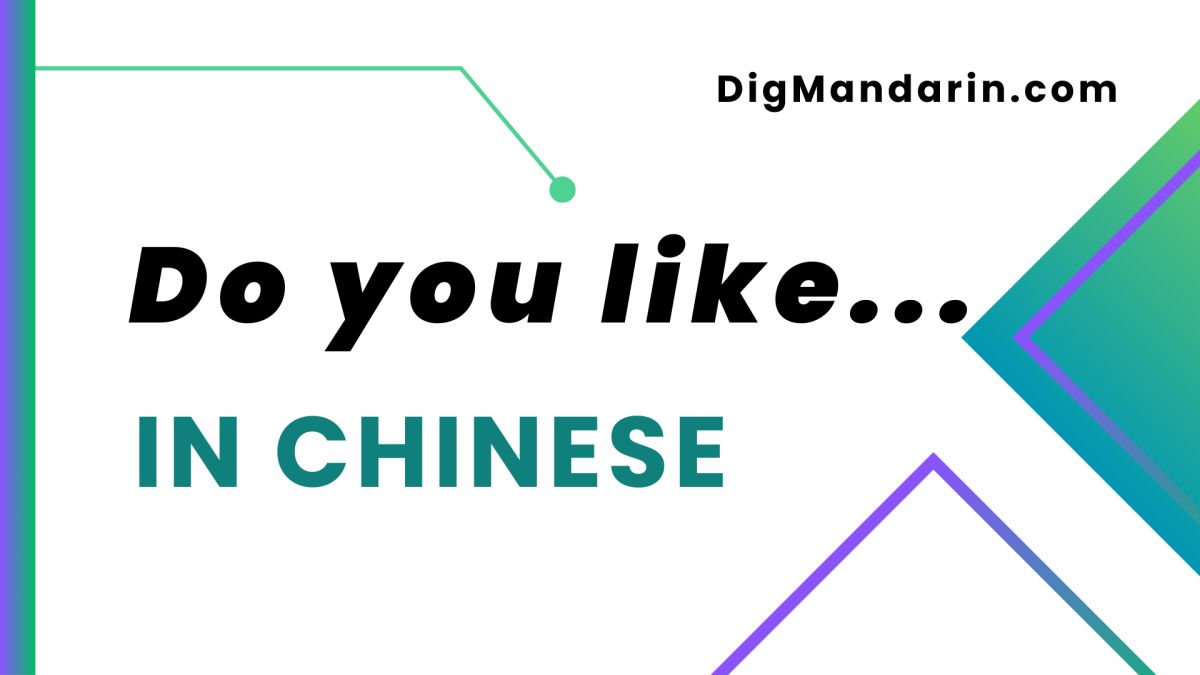
This Post Has 3 Comments
When I used the service of pro essay reviews, I was expecting to have the work which is completely error free and have best quality. I asked them to show me the working samples they have and also their term and condition. They provided me the best samples and i was ready to hire them for my work then.
This is fascinating article, thank you!
Thank you so much for sharing this type of content. That’s really useful for people who want to start learning chinese language. I hope that you will continue sharing your experience.
Leave a Reply Cancel reply
Your email address will not be published. Required fields are marked *

Grammar , Vocabulary
Useful Chinese Essay Phrases
July 8, 2020
By Ellen

Nowadays, many international students have decided to study abroad, and China has become a highly popular destination. In universities, essay writing is a basic skill and the “Academic Writing” lectures are always attracting many students to attend.
Here we have summarized some “all-purpose” phrases and sentences which hopefully you would find useful.
Chinese Essay Phrases Used in Abstracts
The abstract should explain the purpose, method, results, and conclusion of your research, also highlighting the new ideas that you proposed; and do remember to keep your language concise while writing. The purpose of the abstract is to conclude and summarize the main contents of your essay so that the reader could have a brief understanding without having to read the entire paper. Chinese abstracts are usually around 200 characters.
Research Background, Significance, and Current Situation
Extremely useful/badly needed/affecting people’s lives (1-2 sentences)
Proposing the Object of Study
Played a very important role (1-2 sentences)
Purpose of the Study or Study Aim
The role of A in B, perhaps remains to be seen (1 sentence)
Research Methods and Results
Through what means/technique/experiment we achieved what result (several sentences)
Research Results
The phenomenon of A in B, shows what the function of B is, theoretical and applied value (1-2 sentences)

via Pixabay
Chinese Essay Phrases: Main Body
The main body includes the introduction and the main text. The introduction section could use similar phrases that we have just listed, focusing on research objects and purposes. The main text should include research methods, research results, and discussion. Writers should keep their sentences to the point and avoid rambling, also avoid using too much subjective perspective discourses, which shouldn’t be used as arguments as well.
Theoretical Basis, Approaches, and Methods
To express opinions, to emphasis, transitional expressions, chinese essay phrases: conclusion.
At the ending section of the paper, the writer should provide an objective summary, list out the future research objectives and directions, and perhaps look into the future. Keep optimistic even if your experiment results were negative.
Research Impact and Value
There you go. We hope this article helps you write amazing essays. Best of luck!
Ellen is a language specialist from China. She grew up in the US and received a master’s degree from the St Andrews University of UK. The multicultural experiences attributes to her understanding of the differences and similarities between the English and Chinese language. She currently works as an editor specialized in Language learning books.
related posts:
Must-Try Authentic Chinese Dishes
15 must-watch chinese movies for language learners, best chinese music playlists on spotify, get in touch.
How to Write a Chinese Essay?

However, this is not an option.
Chinese essay writing is an important part in GCE O level Higher Chinese Language or Chinese Language exam.
Then, what are the students suppose to write in an essay? For GCE O level Chinese exam in May 2017, many parents complained about the essay questions set were too difficult ( link ). However, this is the direction we are heading in O level Chinese and the students need to level up necessarily.
Before we even talk about what to write, we must first know what will be tested.
For GCE O level Chinese exam , essay writing is in section 2 of Paper 1.
In this section, students are expected to choose to write 1 out of 3 questions, and the 3 questions will be in one of the following categories:
- 情景文 (Scenario essay writing)
- 说明文 (Expository)
- 议论文 (Argumentative)
- 材料作文 (Material essay writing)
Each category would need students to write the essay using different skill set. Students need to master the required skill set in order to write essays that meet the criteria.
For 情景文 , students need to use the skills of writing 记叙文 and characters descriptions ; for 说明文 , they need to use the skills of expository essay writing ; 议论文 needs the 3 key elements; as for 材料作文 , depending on the question, students will either need to use the skills for 记叙文 or 议论文 .
When students are clear with all these skills, they will find Chinese essay writing a lot more easier. When equipped with these necessary writing skills , they will be able to focus more on acquiring their language skills.
With our help, we are confident that our students are able to master all these essential Chinese essay writing skills.
Call 97690373 today to register for our class.
Leave a Comment Cancel Reply
Your email address will not be published. Required fields are marked *
Insert/edit link
Enter the destination URL
Or link to existing content

How to Write a Chinese Essay
by That's Mandarin | Dec 16, 2020

As a Chinese student, learning how to write an essay in this language is very important. After all, how else are you going to express yourself? Writing is one of the ways professors use to teach this language because writing helps with the retention of information.
The more essays you write, the better you get at communicating with Chinese. To write a good essay, you first have to reach a high language mastery level.
Do you admire the students who write seamless Chinese essay? If you do, then you should know that you too can achieve this level of proficiency. In the meantime, don’t be afraid to pay for your essay if you cannot write it on your own. Online academic writers are a resource each student should take advantage of.
Here are tips to help you get better at writing essays in Chinese.

Learn New Chinese Words
The key to communicating in a new language is learning as many words as you can. Take it upon yourself to learn at least one Chinese word a day. Chinese words are to essay writing what bricks are to a building. The more words you have, the better you get at constructing meaningful sentences.
Case in point, if you’re going to write a Chinese sentence that constitutes ten words, but you don’t know the right way to spell three of those words, your sentence might end up not making sense.
During your Chinese learning experience, words are your arsenal and don’t forget to master the meaning of each word you learn.
Read Chinese Literature
Reading is the most effective way of learning a new language. Remember not to read for the sake of it; find out the meaning of each new word you encounter. When you are an avid reader of Chinese literature, nothing can stop you from writing fluent Chinese.
In the beginning, it might seem like you’re not making any progress, but after a while, you will notice how drastically your writing will change. Receiving information in Chinese helps your brain get accustomed to the language’s sentence patterns, and you can translate this to your essays.
Be extensive in your reading to ensure you get as much as possible out of each article. Remember that it’s not about how fast you finish an article, but rather, how much you gain from the exercise.
Translate Articles from your Native Language to Chinese
Have you ever thought about translating your favorite read to Chinese? This exercise might be tedious, but you will learn a lot from it. The art of translation allows you to seamlessly shift from one language’s sentence pattern into the other. The more you do this, the easier it will be for your brain to convert English sentences into Chinese phrases that people can comprehend.
You can always show your Chinese professor your translations for positive criticism. The more you get corrected, the better you will get at translation. Who knows, you might actually like being a translator once you graduate.
Final Thoughts
Writing in Chinese is as foreign as writing in any other language you’re not familiar with. Despite the unfamiliarity, however, it is possible to get better at it with practice. Read as many Chinese articles as you can and make sure you learn at least one new Chinese word each day. In no time, you’ll be at pro at writing Chinese essays.

by Adrian Lomezzo
Adrian Lomezzo is a freelance writer. Firstly, he has been developing as a content manager and working with different websites, and the main goal of his was to develop the content making it in the first place. Secondly, Adrian had a big desire to help students and adults in self-development in this field and teach them to improve their skills. As a lover of traveling, he did not want to be in one place, and became a writer who could be closer to everyone, and share precious information from the corners of the world.
Submit a Comment Cancel reply
Your email address will not be published. Required fields are marked *
Submit Comment

Other posts you might like

Breaking Down Barriers: Movies and TV Shows in Chinese Language Learning
May 26, 2023

China Tourist Visa is Back! Great News for Short-Term Chinese Students
Mar 15, 2023
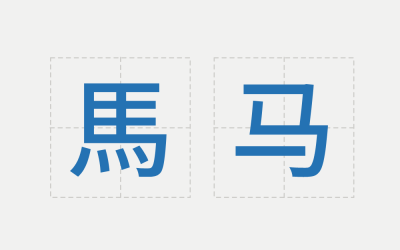
Traditional and Simplified Chinese Characters
Feb 20, 2023
Get 2-week FREE Chinese Classes
Original Price: ¥ 600


Site Content
The chinese essay.
An Anthology
Selected and translated by David Pollard
Columbia University Press
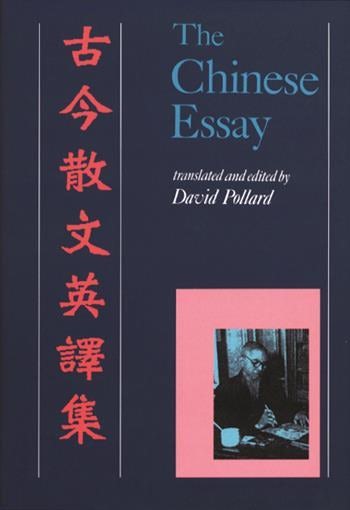
Pub Date: September 2002
ISBN: 9780231121194
Format: Paperback
List Price: $38.00 £32.00
Shipping Options
Purchasing options are not available in this country.
In keeping with its venerable tradition of publishing scholarship on China, Columbia has produced a groundbreaking work edited by a respected Sinologist and translator. In his lengthy and useful introduction to this collection of essays by 36 Chinese authors, Pollard discusses the important differences between the Western notion of 'essay' and its Chinese version--or sanwen (everything that is not a poem)--which is steeped in the classical school curriculum....Pollard's up-to-date, lucid translations of this specialized form of prose can be read effectively as a companion piece to Elizabeth Buckley Ebrey's sourcebook Chinese Civilization and Society (CH, Jul'81) by anyone interested in serious study of Chinese history and culture. B.M. McNeal, Slippery Rock University of Pennsylvnia, Choice
About the Author
- Asian Literature
- Asian Studies
- Asian Studies: Arts and Culture
- Asian Studies: Literary Criticism
- Fiction and Literature
- Literary Studies
%20(1).png)
Ms Chen's 2024 Model Chinese Compo Pack
Learn the best composition techniques, tips and samples from ms chen , help your child gain a headstart and an advantage in chinese compositions.
The Situation
Secondary School Composition Format
There are 3 types of composition questions for O Level Higher Chinese Language / Chinese Language Paper 1.
Narrative (记叙文) - Covered in Sec 1 & 2
Argumentative (议论文) - Covered from Sec 2 onwards or Speech (演讲词) - Covered in Sec 4 and only for HCL
News-based (材料作文) - Covered from Sec 3 onwards
The Problem
The model composition books in the market are too ‘simple’ and do not cater to Higher Chinese students
Many schools encourage students to write Argumentative / News-based (材料作文)during exams
However, many students do not read the news or remember enough evidence (论据) to ace their composition
How you can inspire your child and help him / her improve their Chinese Compositions?
Ms Chen is here to help
Ms Chen's Model Chinese Composition Pack
By subscribing to Ms Chen's Model Composition Pack, you get access to model compositions with topics that are geared towards the latest news and spotted topics for O Level and school exams.
Ms Chen’s past and current students have benefitted from these spotted essay topics.
All the composition topics are from past year top schools' exam papers and O Level exam topics.
Clear annotation and explanation in model compositions to highlight best practices and techniques.
Check-in with Ms Chen if you have any questions.
Model Chinese Compositions (Secondary)
Preview by clicking the buttons
Model Chinese Compositions (Primary)
Preview by clicking the buttons

" 我在考试之前想要复习范文却找不到,无意中发现了陈老师的范文配套。感谢陈老师的范文,涵盖了多方面的话题,包括在O水准的材料文话题,在我准备O水准会考的过程中提供大大的帮助。"
王丹莹,新加坡女子中学 (中四, 2020), the packages.
Ace your Compo
20 Model Compositions (Jan-Oct 2024)
2 Model Compositions sent every first Wednesday of the month (For 10 months)
Narrative + Argumentative (Suitable for Sec 1 and Sec 2 HCL students)
Fee: Contact us to find out
40 Model Compositions (Jan-Oct 2024)
4 Model Compositions sent every first Wednesday of the month (For 10 months)
Narrative + Argumentative + Speech + News-based (Suitable for Sec 3 and Sec 4 HCL/CL students, lower sec students who wish to have a head start in news-based composition)
Primary School Package
4 Model Compositions sent every last Wednesday of the month (For 10 months)
4 Compo Types - 看图作文, 命题作文 (普华), 情境作文, 完成文章 (高华).
Who is it suitable for?
Primary School students taking PSLE
Secondary School students taking Higher Chinese Language
Secondary School students taking Chinese Language and would like to stretch your Composition skills and knowledge
Mode of payment for Ms Chen's Model Composition Pack is via bank / Paynow transfer.
1) Bank transfer (FAST): UOB 456-345-3375 OR
2) Paynow to Mobile: +65 91558311
By subscribing to Ms Chen's Model Composition Pack, you consent and agree to the Terms and Conditions .
Once you have made the bank / Paynow transfer, kindly drop a note to [email protected] or text 91558311 with the following details:
Package Subscribed (Package A / Package B / Primary School)
Amount Transferred
Date of Transfer
Email address to receive the Model Composition Pack
Your payment will be verified in the next 24 hours. Once verified, you will receive a successful enrolment notification.
If you subscribe in the middle of the year once the publications have started (e.g. May 2024), you will have access to all model compositions published from the start of the same calendar year, i.e. Jan to May 2024.
For enquiries, please reach out to Ms Chen using this form .
The Chinese Essay
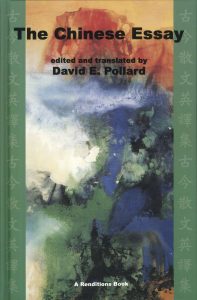
Edited and translated by David E. Pollard
1999 400 pages ISBN 962-7255-21-1
Table of Contents
Introduce Yourself in Chinese with Self-Introduction Speech Examples
How to introduce yourself in chinese.
It is not difficult to introduce yourself in Chinese language as they are fixed answers which you memorise about yourself. However, it is not that easy to be able to understand all the variations of questions asked. Therefore, in this article, you will also learn about various ways of questioning and response, so you know they mean the same thing and handle the Chinese self-introduction with ease.
For a start, I have prepared three articles below with audio on self-introduction speech examples, changing the variation of replies in Chinese for beginners when you introduce yourself in Mandarin. The questions and answers will revolve around: –
① Chinese Greetings and Pronouns ② Your Name and Surname ③ Your Age ④ Your Country and Nationality ⑤ Your Hobby and Interest ⑥ Your Relationship and Marital Status
It is always a good practice to read and listen in Mandarin to guess the meaning of the articles before looking at the English translation.
Chinese Self-Introduction Essay and Speech Samples
你们好! 我叫芮。 其实,芮是我的姓氏。我是华人。我来自新加坡。不过,我现在居住安特卫普,比利时的一个美丽城市。我有一个英俊的比利时男友。我会说英语、华语、广东话、法语和荷兰语。现在,我和你们一样,都在学习语言。我每天要去学校上荷兰语课。
平时,在业余时间,我写博客和上网查询资料。在周末,我喜欢和我的男朋友一起骑自行车,拍照,购物和吃饭。 我最喜欢去餐馆吃中餐。我的最爱是旅行。我去过很多国家。
那你呢?请你自我介绍,告诉我平时你喜欢做些什么?请留言。
Hāi! Dú zhě men,
Nǐ men hǎo! Wǒ jiào Ruì. Qí shí, Ruì shì wǒ de xìng shì. Wǒ shì huá rén. Wǒ lái zì xīn jiā pō. Bù guò, wǒ xiàn zài jū zhù ān tè wèi pǔ, bǐ lì shí de yī gè měi lì chéng shì. Wǒ yǒu yīgè yīng jùn de bǐ lì shí nán yǒu. Wǒ huì shuō yīng yǔ, huá yǔ, guǎng dōng huà, fǎ yǔ hé hé lán yǔ. Xiàn zài, wǒ hé nǐ men yī yàng, dōu zài xué xí yǔ yán. Wǒ měi tiān yào qù xué xiào shàng hé lán yǔ kè.
Píng shí, zài yè yú shí jiān, wǒ xiě bó kè hé shàng wǎng chá xún zī liào. Zài zhōu mò, wǒ xǐ huān hé wǒ de nán péng yǒu yī qǐ qí zì xíng chē, pāi zhào, gòu wù hé chī fàn. Wǒ zuì xǐ huān qù cān guǎn chī zhōng cān. Wǒ de zuì ài shì lǚ xíng. Wǒ qù guò hěn duō guó jiā.
Nà nǐ ne? Qǐng nǐ zì wǒ jiè shào, gào sù wǒ píng shí nǐ xǐ huān zuò xiē shén me? Qǐng liú yán.
Hi Readers,
How are you? I am called Rui. In fact, Rui is my surname. I am a Chinese. I come from Singapore. However, I am now living in Antwerp, a beautiful city in Belgium. I have a handsome Belgian boyfriend. I can speak English, Mandarin, Cantonese, French, and Dutch.
Now, I am like you, learning a language too. Every day, I go to school for my Dutch class. Usually, during my spare time, I blog and surf the internet for information. During the weekend, I like to cycle with my boyfriend, take photographs, shopping and eating. I also like going to restaurants to eat Chinese food. My favourite is travelling. I have been to many countries.
How about you? Please introduce yourself. Tell me what do you usually like to do? Please leave a message.
我的名字是彼得。 我今年27岁。 我从美国来的。 我还单身,也没有女朋友。 我会说英语和一点点西班牙语。我也在学习汉语。可是,我的中文说的不太好,还可以在进步。
我想去中国旅行。我对中国的文化和语言很感兴趣。我希望找一位中国女友。我可以向她学习中文。我也能教她英语。我很好动。平时,我喜欢做运动, 例如跑步和游泳。
Hāi! Nín hǎo!
Wǒ de míng zì shì Bǐ Dé. Wǒ jīn nián 27 suì. Wǒ cóng měi guó lái de. Wǒ hái dān shēn, yě méi yǒu nǚ péng yǒu. Wǒ huì shuō yīng yǔ hé yī diǎn diǎn xī bān yá yǔ. Wǒ yě zài xué xí hàn yǔ. Kěs hì, wǒ de zhōng wén shuō de bù tài hǎo, hái kěyǐ zài jìn bù.
Wǒ xiǎng qù zhōng guó lǚ xíng. Wǒ duì zhōng guó de wén huà hé yǔ yán hěn gǎn xìng qù. Wǒ xī wàng zhǎo yī wèi zhōng guó nǚ yǒu. Wǒ kě yǐ xiàng tā xué xí zhōng wén. Wǒ yě néng jiào tā yīngyǔ. Wǒ hěn hào dòng. Píng shí, wǒ xǐ huān zuò yùn dòng, lì rú pǎo bù hé yóu yǒng.
My name is Peter. I am 27 years old this year. I come from the United States. I am still single and also do not have a girlfriend. I speak English and some Spanish. Now, I am also learning Chinese. However, I do not speak Mandarin so well. It can still be improved.
I wish to travel to China. I am very interested in Chinese culture and language. I hope to find a Chinese girlfriend. I can learn Chinese from her. I can teach her English. I am very active. Usually, I like to exercise such as jogging and swimming.
我是爱丽丝。大家都叫我丝丝。我是加拿大人。十年前,我从加拿大搬迁到台湾工作。我学了五年的中文,现在能说一口流利的华语。我现年四十岁。 我已婚,嫁给了一位台湾人。我有两个孩子,一个儿子和一个女儿。
我的嗜好是烹饪、阅读、听音乐和教书。我是一名教师。 我会说流利的英语、华语、 法语和一点点葡萄牙语。我不太喜欢做运动。不过,我很喜欢旅行,到处走走。
Hāi! Nǐ hǎo!
Wǒ shì Ài Lì Sī. Dà jiā dōu jiào wǒ Sī Sī. Wǒ shì jiā ná dà rén. Shí nián qián, wǒ cóng jiā ná dà bān qiān dào tái wān gōng zuò. Wǒ xué le wǔ nián de zhōng wén, xiàn zài néng shuō yī kǒu liú lì de huá yǔ. Wǒ xiàn nián sì shí suì. Wǒ yǐ hūn, jià gěi le yī wèi tái wān rén. Wǒ yǒu liǎng gè há izi, yīgè er zi hé yī gè nǚ’ér.
Wǒ de shì hào shì pēng rèn, yuè dú, tīng yīn yuè hé jiāo shū. Wǒ shì yī míng jiào shī. Wǒ huì shuō liú lì de yīng yǔ, huá yǔ, fǎ yǔ hé yī diǎn diǎn pú táo yá yǔ. Wǒ bù tài xǐ huān zuò yùn dòng. Bù guò, wǒ hěn xǐ huān lǚ xíng, dào chù zǒu zǒu.
Hello, my name is Alice. Everyone call me Si Si. I’m a Canadian. Ten years ago, I relocated from Canada to work in Taiwan. I have studied Chinese for five years. Now, I speak Mandarin fluently. This year, I am 40 years old. I am married to a Taiwanese. I have two children, a son and a daughter.
My hobby is cooking, reading, listening to music and teaching. I am a teacher. I speak fluent English, Mandarin, French and a little bit of Portuguese. I do not like so much to do sports. However, I enjoy travelling and walk around.
① Chinese Greetings and Pronouns
How to say “hello” in chinese.
For the Chinese, it is common to greet in person with 嗨!你好! It has a similar connotation as “Hello, how are you?” but not a question asked like 你好吗? to get a response. The Chinese greeting means “ You are fine! ” Since the tone of the sentence is an exclamation mark, the other party is not expected to give a reply to 你好!
The pronouns used in the three self-introduction speech in Chinese is: –
- 读者们 | dú zhě men | Readers
- 你们 | nǐ men | You (Plural)
- 您 | nín | You (Formal address of someone of a higher authority, a stranger or out of courtesy)
- 你 | nǐ | You (Singular. Informal way and most commonly used to address among friends and people)
Whenever you see the word 们 | mén , with a pronoun, it always refers to a plural form of a pronoun. You can virtually place the Chinese plural word 们 behind any nouns, but usually for humans and animals.
② What is Your Name? Introduce Yourself in Chinese
The first sentence that most people learn is likely “What is your name?”. In a more formal setting, you can be asked to introduce yourself instead of someone asking you to say your name. Both sentences can be applied at the same time too.
How to Say “What is Your Name” in Chinese?
What is your name? Please introduce yourself OR Please self-introduced.
你叫什么名字? 请介绍一下你自己。 ( 或者 | or) 请自我介绍。
Nǐ jiào shén me míng zì? Qǐng jiè shào yī xià nǐ zì jǐ. (huò zhě) Qǐng zì wǒ jiè shào.
How to Say “What is Your Surname?” in Chinese? – Formal
Here, you can see the formal pronoun 您 | you being used asking for only the surname (family name) instead of the person’s name. The person asking for only the family name wants to address the other party as Mr, Mrs or Miss + Surname.
One example is a shop assistant serving his customer. The Chinese find it more respectful to call a person by the surname when they do not know him well or when the status is higher. However, the person replying back do not need to use 您 and may use 你 instead.
I presume that if you are a foreigner especially a Caucasian, the Chinese would not ask you this question. Next time, you can also ask 您贵姓? to Chinese people if you meet them for the first time.
What is your surname? (Polite)
您贵姓? Nín guì xìng?
My surname is Li. How about you?
我姓李。那你呢? Wǒ xìng Lǐ. Nà nǐ ne?
Hi, Mr Lee. My surname is Rui. Pleased to meet you! / It is an honour to meet you!
李先生,您好。我姓芮。幸会,幸会! Lǐ xiān shēng, nǐn hǎo. Wǒ xìng Ruì. Xìng huì, xìng huì!
How to Say “Who Are You” in Chinese?
Asking someone “Who are you?” is an abrupt and less friendly way when asking for a self-introduction. However, it has to depend on the tone used and the situation. 你是谁? can have an implied meaning of curiosity, uncertainty, suspicion or fear.
Example – You went to your friend’s house to look for her. She was not at home. The mother opened the house and saw you. She asked,“ 你是谁呀? ” Then, you have to introduce yourself in Mandarin.
Who are you?
你是谁(呀)? Nǐ shì shéi (ya)?
How to Say “My Name is … ” in Chinese?
There are three ways that you can introduce yourself with “My name is ___”.
a) I am called Rui. b) My name is Peter. c) I am Alice. Everyone calls me Si Si (nickname). You can call me Alicia or Si Si.
a) 我叫芮。 b) 我的名字是彼得。 c) 我是爱丽丝。大家都叫我丝丝。你可以叫我爱丽丝或者是丝丝。
a) Wǒ jiào Ruì. b) Wǒ de míng zì shì Bǐ dé. c) Wǒ shì Ài Lì Sī. Dà jiā dōu jiào wǒ sī sī. Nǐ kě yǐ jiào wǒ Ài Lì Sī huò zhě shì Sī Sī.
③ How Old Are You?
The first two questions are common ways to ask someone their age. You can refer to the Chinese numbers of your age.
How to Say “What is Your Age” in Chinese?
What is your age?
a) 你今年几岁了?(或者 | or) 今年你几岁了? b) 你今年多少岁了?
a) Nǐ jīn nián jǐ suì le? (huò zhě) Jīn nián nǐ jǐ suì le? b) Nǐ jīn nián duō shǎo suì le?
How to Say “How Old are You” in Chinese?
To ask someone’s age, “How OLD” in Chinese, is not a direct translation of the English word “old”. The literal translation of “How old” would be “ 多老 “. “老” means aged, senior. Please do not ask someone “ 你多老? ” because the Chinese will never ask a person’s age this way. It is quite offensive to use the Chinese word 老 | lǎo when talking to someone.
Instead, we use the phrase “how big – 多大 ” to ask someone’s age. Note that the phrase “ 多大 ” can have an ambiguous meaning. It can directly refer to the size of the object that you are discussing and not about age. The preferred sentence is still 你今年几岁了? when meeting someone for the first time.
How old are you?
a) 你多大年纪? b) 你多大年龄? c) 你多大了?
a) Nǐ duō dà nián jì? b) Nǐ duō dà nián líng? c) Nǐ duō dà le?
How to Say “How old are you” in a Formal Way?
However, it is considered abrupt and rude to ask a senior, elderly or someone respectable on their age with the sentence construction above. In a formal situation or writing, we ask people on their age with 您今年贵庚? It is more polite asking when you hold high regard for someone.
How old are you? (Formal)
您今年贵庚? Nín jīn nián guì gēng?
How to Say “Your Age” in Chinese?
It is easy to say your age in Chinese. There are not many variations. You only have to know the Chinese numbers so you can tell your age to others.
I am 35 years old this year.
我今年35岁。 Wǒ jīn nián sān shí wǔ suì.
Pardon! My Age is Confidential!
Women are more reserved and sensitive when it comes to divulging their age especially Chinese women. Looks matter to many of them and they care about how people look at them.
Many of them also spend a lot of money, time and effort to maintain their youth. They hope to give a lasting impression of looking young forever.
Therefore, if you do not know a Chinese woman long enough, refrain from asking her age as you never know how she feels about telling it to you. Maybe she is fine with the question. Or, perhaps she does not like it and would not say it frankly.
Sorry, my age is a secret. Woman‘s age is always confidential.
不好意思,我的年龄是秘密。 女人的年龄是保密的。 Bù hǎo yì si, wǒ de nián líng shì mì mì. Nǚrén de nián líng shì bǎo mì de.
④ Where Are You From?
When someone asks you “where are you from”, you can tell them either your country of origin or your nationality. It is not necessary to say both unless you have a different nationality than that of the country that you live.
How to Say ” Where are you from” in Chinese?
Where are you from?
你从哪里来?(或者 | or) 你来自哪里? Nǐ cóng nǎ lǐ lái? (huò zhě) Nǐ lái zì nǎ lǐ?
How to Say “Which country are you from” in Chinese?
Which country are you from?
你来自什么国家? (或者 | or) 你从什么国家来的? Nǐ lái zì shén me guó jiā? (huò zhě) Nǐ cóng shén me guó jiā lái de?
How to Say “What is Your Nationality” in Chinese?
How to say Nationality 国籍 | Guó jí in Chinese? Most of the time, you use the {name of the country + 人 |people}to derive the nationality.
Which country are you from? OR Who are you?
a) 你是什么国家的人? (或者 | or) 你是什么人? b) 你是哪里人?
a) Nǐ lái zì shén me guó jiā? (huò zhě) Nǐ cóng shén me guó jiā lái de? b) Nǐ shì nǎ lǐ rén?
How to Say “Do You Come from (Country)” or “Are You (Nationality)” in Chinese?
Do you come from America? Are you an American?
你从美国来的吗?你是美国人吗? Nǐ cóng měi guó lái de ma? Nǐ shì měi guó rén ma?
How to Say “Your Country and Nationality” in Chinese?
I am American, from California.
我是美国人,来自加州。 Wǒ shì měi guó rén, lái zì jiā zhōu.
I come from Germany (or) I am from Germany (Berlin).
我从德国来 (或者 | or) 我来自德国(柏林)。 Wǒ cóng dé guó lái (huò zhě) wǒ lái zì dé guó (bó lín).
I come from Italy but I am a Turk.
我来自意大利,但我是土耳其人。 Wǒ lái zì yì dà lì, dàn wǒ shì tǔ’ěr qí rén.
I am not Dutch. I am French.
我不是荷兰人。我是法国人。 Wǒ bù shì hé lán rén. Wǒ shì fà guó rén.
I do not come from England. I am Australian.
我不是从英国来的。我是澳大利亚人。 Wǒ bù shì cóng yīng guó lái de. Wǒ shì ào dà lì yǎ rén.
⑤ What Do You Like to Do? Hobby and Interest
The questions below are all referring to the same things. That is your hobbies and interests. Sometimes, the word 平时 | píng shí is added and means ‘usually’. I will prepare a list of activities about hobbies and interests in the near future so you can make references to what you like to do.
How to Say “What Do You Like to Do” in Chinese?
What do you like to do?
你喜欢做(些)什么? Nǐ xǐ huān zuò (xiē) shén me?
I like jogging and swimming.
我喜欢跑步和游泳。 Wǒ xǐ huān pǎo bù hé yóu yǒng.
How to Say “What is Your Interest” in Chinese?
What is your interest?
你的兴趣是什么? Nǐ de xìng qù shì shén me?
My interest is surfing the net and shopping.
我的兴趣是上网和逛街。 Wǒ de xìngqù shì shàng wǎng hé guàng jiē.
How to Say “What is Your Hobby” in Chinese?
What is your hobby?
你的嗜好是什么 你的爱好是什么?
Nǐ de shì hào shì shén me? Nǐ de ài hào shì shén me?
My hobby is reading, listing to music and watching movies.
我的嗜好是。。。阅读、听音乐和看电影。 Wǒ de shì hào shì yuè dú, tīng yīn yuè hé kàn diàn yǐng.
⑥ What is Your Marital Status?
Western men looking for a Chinese girlfriend would always be happy to declare that he is single and available. He also wants to know whether they are still single and available or married. It is just an illustration and applies to anyone who wants to say about their relationship status.
How to Say “What is Your Marital Status” or “Relationship Status” in Chinese?
To be honest, I have never had anyone asked me about my marital status 你的婚姻状况是什么? except when filling up forms because it sounds too formal. Many would just ask me about my relationship status “Are you married?” or “Do you have a boyfriend?”
It is always good to know the Chinese phrase ‘marital status’ for administration purpose and the different status as part of introducing yourself in Chinese to others.
What is your Marital Status?
你的婚姻状况是什么? Nǐ de hūn yīn zhuàng kuàng shì shén me?
How to Say “Are You Single” in Chinese?
Most importantly, people want to know whether you are single or married.
Are you single? OR Are you still single?
你单身吗?( 或者 | or) 你还单身吗? Nǐ dān shēn ma? (huò zhě) Nǐ hái dān shēn ma?
How to Say “Do You Have a Boyfriend” in Chinese?
Do you have a boyfriend?
你有男朋友吗? Nǐ yǒu nán péng yǒu ma?
Are you seeing anybody? Do you have someone in mind?
你有对象吗? Nǐ yǒu duì xiàng ma?
How to Say “Are You Married” in Chinese?
Are you married?
你结婚了吗? Nǐ jié hūn le ma?
How to Say “I am Single” in Chinese?
I am single and have no girlfriend.
我单身, 也没有女朋友。 Wǒ dān shēn, yě méi yǒu nǚ péng yǒu.
I am still single but I have a boyfriend.
我还单身, 但是我有一个男朋友。 Wǒ hái dān shēn, dàn shì wǒ yǒu yī gè nán péng yǒu.
I am not married.
我未婚 ( 或者 | or) 我还没结婚。 Wǒ wèi hūn (huò zhě) Wǒ hái méi jié hūn.
How to Say “Got Engaged, Fiance and Fiancee” in Chinese?
I am engaged. He is my fiance. She is my fiancee.
我订婚了。 他是我的未婚夫。 她是我的未婚妻。
Wǒ dìng hūn le. Tā shì wǒ de wèi hūn fū. Tā shì wǒ de wèi hūn qī.
How to Say “I am Married” in Chinese?
I am married.
我已婚 (或者 | or) 我结婚了。 Wǒ yǐ hūn (huò zhě) Wǒ jié hūn le.
How to Say “I am Divorced or a Divorcee” in Chinese?
I am divorced. I am a divorcee.
我离婚了。 我是离婚者。 Wǒ lí hūn le. Wǒ shì lí hūn zhě.
How to Say “I am Separated” in Chinese?
I am in the midst of a separation.
我在分居状态中。 Wǒ zài fēn jū zhuàng tài zhōng.
How to Say “Widow” and “Widower” in Chinese?
For widows and widowers, it is not necessary to mention that. The Chinese might find it awkward to reply back. Just say that you are still single if you do not want to be too frank. After all, the Chinese are usually reserved people if you do not know them well and would not go too deep into such a topic.
I would think that not many people would say upfront that “I am a widow or widower” as it is somewhat private to use as a self-introduction in Chinese. Nonetheless, the Chinese sentences below are for information.
I am a widow. My husband passed away two years ago.
我是个寡妇。我的丈夫2年前去世了。 Wǒ shì gè guǎ fù. Wǒ de zhàng fū liǎng nián qián qù shì le.
I am a widower. My wife recently passed away due to sickness.
我是个鳏夫。我的妻子不久前病世了。 Wǒ shì gè guān fū. Wǒ de qī zi bù jiǔ qián bìng shì le.
Your Turn to Introduce Yourself in Chinese
So, now is your turn. Leave a reply to me in Chinese (or English) and tell us about yourself. 请你告诉我,平时你喜欢做些什么呢? Take it as a practice and show us what you have learnt. I will reply back to you 🙂
Related Articles

How to Say “Master” in Chinese? 师傅 & 师父 Shifu Meaning in Mandarin

How to Say “Teacher” in Chinese? 老师 Laoshi, 教师 Jiaoshi, 导师 Daoshi in Mandarin

How to Express Sentences with Colors in Mandarin?
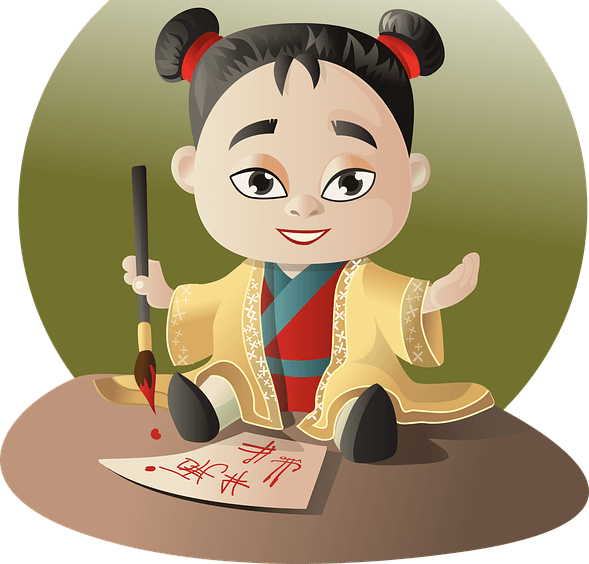
5 Exceptional Reasons to Learn Mandarin & Chinese Language
One comment.
my name is haleema sadia .im from india .im 18 yrs old.i love chinese culture and languagei started studying chinese from 2 months.i want to visit china as soon as possible.
Leave a Reply Cancel reply
Your email address will not be published. Required fields are marked *
Please enter an answer in digits: eight − seven =
Currently you have JavaScript disabled. In order to post comments, please make sure JavaScript and Cookies are enabled, and reload the page. Click here for instructions on how to enable JavaScript in your browser.

International Conference on Frontiers in Handwriting Recognition
ICFHR 2022: Frontiers in Handwriting Recognition pp 231–244 Cite as
FPRNet: End-to-End Full-Page Recognition Model for Handwritten Chinese Essay
- Tonghua Su ORCID: orcid.org/0000-0002-8869-1664 10 ,
- Hongming You 10 ,
- Shuchen Liu 10 &
- Zhongjie Wang ORCID: orcid.org/0000-0002-9084-7373 10
- Conference paper
- First Online: 25 November 2022
1107 Accesses
2 Citations
Part of the book series: Lecture Notes in Computer Science ((LNCS,volume 13639))
Handwritten Chinese Essay Recognition (HCER) is a special branch of handwritten Chinese text recognition with great interest. In a naive way, it can be firstly segmented into text lines or even characters, followed by a text line or character recognition step. Instead, we propose an end-to-end recognition model named FPRNet which directly runs on full-page images in light of the segmentation-free strategy. Our well-designed model can extract text from a full-page image only supervised with text labels and adapt better to authentic noisy images. Besides, we propose an effective dimensionality reduction mechanism based on reshape operation to bridge features between 2D and 1D without information loss. Moreover, we propose an order-align strategy to mitigate the decoding confusion caused by skewness. Experiments are conducted on real-world essay images. Our model achieves a 5.83% character error rate (CER), which is comparable with the state-of-the-art approaches.
Download conference paper PDF
1 Introduction
Handwritten Chinese Text Recognition (HCTR) has been a long-term research task in pattern recognition and document analysis [ 1 , 2 ]. In general, the goal of the HCTR task is to transcribe handwritten text images into a machine-encoded form so that downstream tasks can freely use the text. With the rise and popularization of deep learning technology, the HCTR system is widely used in office automation, forms automation, and AI-assisted education.
Typically, HCTR research focuses on line-level texts. Full-page text recognition is usually achieved in two steps [ 3 , 4 ]. It is segmented at the line level firstly. Then a recognition model will transcribe text from the segmented images. However, as a matter of fact, segmentation error will seriously affect the final recognition performance. Producing segmentation labels on massive data is also too costly [ 16 ].
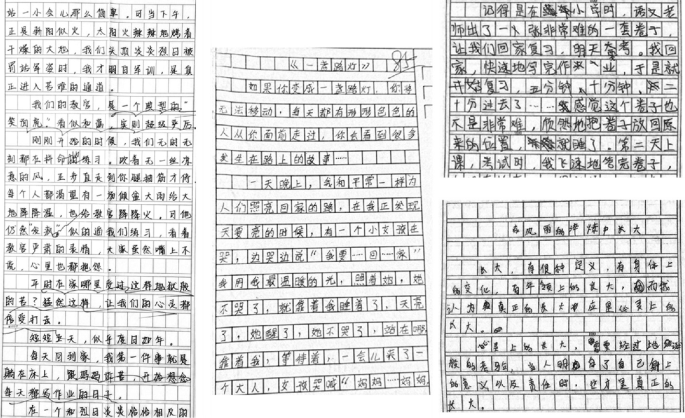
Examples of authentic handwritten Chinese essay images. Left: samples with correction and noises. Middle: samples with scanning. Right: samples with modifications and different character scales.
In many real-world scenarios, handwritten Chinese essay recognition (HCER) system based on HCTR faces more complex challenges. In the case of education, there exists miswriting, writing separately, scribble marks, complex grid backgrounds, distorting scanning, and so on (Fig. 1 ). In addition, we need to consider various types of composition paper templates, different line spacing, and different character scales. Using language models like most state-of-the-art works [ 5 ] generally to enhance the model results is also not allowed because this might correct students’ miswritten unintentionally.
This paper aims at providing a full-page recognition model (FPRNet) to meet the mentioned challenges. We construct a novel encoder-decoder architecture driven by CTC loss [ 6 ] lending recent advances in full-page text recognition works.
Our proposed model employs the encoder-decoder structure. As for the encoder, we design an architecture integrating gating mechanism and multi-branch structure. This architecture also refers to the MobileNetV2 [ 7 ] and reduces computational consumption by using pointwise convolution and depthwise convolution. To mitigate the mapping gap between 2D image and 1D text string, we leverage the reshape operation to align the output text and feature maps more precisely. Furthermore, we propose an order-align strategy to alleviate decoding confusion caused by skewness. The resultant method demonstrates a comparable performance with traditional methods.
This paper is organized as follows. Section 2 gives an overview of related work on the field. Section 3 describes our architecture design in detail. Section 4 describes the experiments and presents its result. Finally, concluding remarks are given in Sect. 5 .
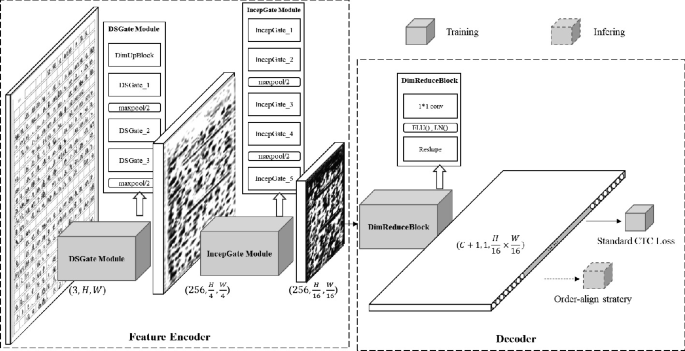
Overview of the proposed FPRNet.
2 Related Works
We classify the previous works into two categories. Those requiring segmentation and ground-truth in line-level are called segmentation-based approaches. The other segmentation-free approach, which only requires ground-truth in full-page level, has been a recent hot research topic.
2.1 Segmentation-Based Approaches
The segmentation-based approach has been studied for a long time. The models proposed in [ 8 , 9 ] use a region proposal network and region of interest pooling to obtain bounding boxes for each word or line in the input image.
Subsequently, a single-line text recognition model transcribes the text from the boxes. A typical single-line text recognition model uses a CTC-based approach to convert text images into segmented sequences, and then decodes the sequences using a dynamic programming approach. Many kinds of architectures have been proposed for single-line text recognition. Multi-Dimensional Long-Short Term Memory(MDLSTM) [ 10 ] is used to recognize Chinese character lines. [ 11 ] proposes a separable MDLSTM-RNN model, which is able to extract contextual information in different directions. [ 12 ] proposes a general framework based on Gated CNN, which achieves higher computational efficiency.
2.2 Segmentation-Free Approaches
A segmentation-free approach is dedicated to achieving detection and recognition of multi-line images simultaneously or considering detection only as an implicit task without considering intermediate detection results. [ 13 ] proposes a segmentation-free approach based on MDLSTM, where a two-dimensional feature map is obtained by encoding. [ 14 ] illustrates a new SFR model consisting of three modules, in which the line head detection module locates the initial position of a text line by regression calculation of the horizontal and vertical offset of the line head point relative to the center of the lattice. [ 15 ] proposes a unified end-to-end model using hybrid attention to iteratively process a paragraph image line by line. [ 16 ] directly performs a segmentation-free and annotation-free one-stage end-to-end recognition model for multi-line handwritten text. The authors extended the traditional CNN+CTC single-line text recognition method by transforming the multi-line feature map into single-line features by stretching it in the vertical direction through several bilinear interpolations and convolutional layers.
In this work,we suggest combining the advantages of efficient single-line text recognition and multi-line segmentation-free approach to design an end-to-end full-page recognition method.
3 Architecture
Our proposed Full-Page Recognition Network (FPRNet) consists of two major procedures. One is an encoder based on depthwise separable convolution, Inception block and gate block. The other is a decoder based on dimensionality reduction block that enables the decoder to focus on the most relevant encoded features at each decoding time step. We also propose an order-align strategy to improve the orderliness of recognition result on skew images. Figure 2 illustrates the overview of the proposed model architecture.
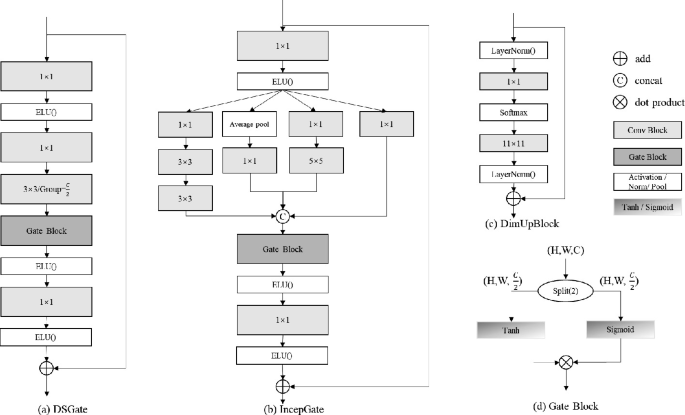
The structure of primary building blocks in FPRNet. a) DSGate is an efficient block widely used in the encoder. b) IncepGate can learn spatial patterns at different scales. c) DimUpBlock is used in the front of FPRNet. d) the attention gates used to control the information flow and enhance model representation.
3.1 Encoder
As shown in Fig. 2 , the encoder extracts features \(f\) from input image \(X\) . It consists of a DSGate module and an IncepGate module, being mainly made up of a sequence of depthwise separable gate block (DSGate) and Inception gate block (IncepGate) respectively.
DSGate Block depicted in Fig. 3 (a) is a residual block. Residual connections with element-wise sum operation enable strengthening the parameters update during backpropagation. It can be written as
DSGate is motivated by the Inverted Residual Block in MobileNet V2 [ 7 ]. It can be factored into three parts: mapping \(M(\cdot )\) from input space \(\textbf{R}^{H\times W\times C}\) to the lower dimensional depthwise convolution space \(\textbf{R}^{H\times W\times \frac{c}{2}}\) , extracting \(G(\cdot )\) image feature in the low dimensional space, and projecting \(H(\cdot )\) back to the original dimensional input space. Then, Eq. 1 can be written as:
In DSGate block, \(M(\cdot )\) and \(H(\cdot )\) are both a \(1 \times 1\) convolution. \(G(\cdot )\) consists of a depthwise separable convolution and a gate block. Depthwise separable Convolutions are a key building block for many efficient neural network architectures [ 17 , 18 ]. Standard convolution takes an \(h_i \times w_i \times d_i\) input tensor and produces an \(h_i \times w_i \times d_j\) output tensor applying convolution kernel \(K \in R^{k \times k \times d_i \times d_j}\) . By splitting a full convolution into two separate layers, including a depthwise convolution and a 1 \(\times \) 1 pointwise convolution, the computational cost drop from \(h_i \times w_i \times d_i \times d_j \times k^2\) to \(h_i \times w_i \times d_i \times (d_j + k^2)\) . With the help of depthwise separable convolution, our architecture is trained at a faster convergency speed and lower computational cost without significantly reducing recognition accuracy.
The gates block, which controls the information flow has shown the strength in filtering-out unimportant background noise and sharpening signals [ 19 ]. Inspired by typical works as [ 12 , 20 ]. The attention gate structure with both tanh and sigmoid is also adopted by newer publications such as [ 21 ]. Let \(x\) of dimension \(H \times W \times C\) be the input of the gate block. We propose to split the feature maps into two parts along with channel \(C\) . The first one refers to a traditional \(tanh\) activation, while the second one refers to the gating operation modeled using a \(sigmoid\) activation and acts as a self-attention mechanism over the first part. Let \(i\) , \(j\) and \(k\) be the index in the feature map, each pixel of output \(o\) can be then computed:
where \(i\in \{1,...,W\}\) , \(j\in \{1,...,H\}\) ,and \(k\in \{1,...,\frac{C}{2}\}\) . \(tanh\) represents the hyperbolic tangent function and \(\sigma \) represents the sigmoid function. The gate block is depicted in Fig. 3 (d).
Besides, Exponential Linear Units (ELU) activation function is also used in DSGate to increase convergence speed. The detailed list of layers and their configuration is shown in Table 1 .
IncepGate Block is depicted in Fig. 3 (b), which is similar to DSGate. The most significant difference is changing depthwise separate convolution to an Inception block which is proposed in GoogLeNet [ 22 ]. It allows for the utilization of varying convolutional filter sizes to learn spatial patterns at different scales. In the adopted Inception block, the input feature map is processed by four branches, and the results are jointly entered into the following blocks to get the final output. The mapping, projecting, activation, and residual connections are fully reserved.
Now, we describe more details in the encoder. It takes an image \(X \in R^{H \times W \times 3}\) as input. Firstly, the input is fed to DimUpBlock, which is presented in Fig. 3 (c). DimUpBlock starts with a layer normalization, which directly estimates the normalization statistics from the summed inputs within a single layer without introducing any new dependencies between training cases. The input features are then projected to a high dimension with a \(1\times 1\) convolutional layer. After normalizing by softmax, the feature will be fed to a depth-wise convolution with a \(11\times 11\) filter. Following a layer normalization layer and residual connection, the output of DimUpBlock is given to three continuous DSGate blocks and five IncepGate blocks. Noteworthy, the max pooling layer, whose stride is 2, is used after every two blocks to reduce feature map size. After this step, we have computed the feature \(f \in R^{ \frac{H}{16} \times \frac{W}{16} \times 256}\) .
3.2 Decoder
As described above, we cannot use language models to correct typos in essay recognition tasks because students may write incorrectly, which is a factor in essay scoring. Thus, we train our model with the standard Connectionist Temporal Classification(CTC) loss function [ 6 ], which is termed as an alignment-free approach to sequence transduction. Before feeding the encoder-extracted feature \(f\) to the CTC function, we must devise methods to serialize the two-dimensional features to one-dimensional features.
OrigamiNet [ 16 ] proposes to use a series of up-scaling operations followed by convolution to unfold the 2D signal into single-line features. This approach achieves good results on multi-line English handwriting recognition, but the HCER task needs to face thousands of characters, multi-layer convolutions after up-scaling bring in a vast number of parameters. Through experiments, it was found that reducing the number of up-scaling layers and convolutions would seriously weaken the unfolding effect. In addition, the down-sampling operation performed on the feature map in the horizontal direction appears to be severely information-deficient, and the model cannot retain the implicit spatial information of the text effectively.
Owing to the above problems, we propose the dimensionality reduction block (DimReduceBlock) to unfold feature maps. Let \(N\) be the size of the charset. The encoder-extracted feature \(f\) is fed into a single convolution with \( 1\times 1\) kernel and changes to N + 1 dimensions. Afterward, we reassemble 2D feature maps from top to bottom, left to right, using the reshape operations. Moreover, ELU activation and layer normalization are also used after convolution. The architecture of DimReduceBlock is shown in Fig. 2 .
Similar to [ 25 ], the proposed dimensionality reduction mechanism based on reshape operation better preserves the encoder-extracted features and the independence between tokens. Each location in the serialized feature map focuses more on the visual information within the field of perception. In turn, a more accurate implicit alignment between the output text and the original image is achieved. The advantages of the decoder will be further demonstrated visually in the Sect. 5 .
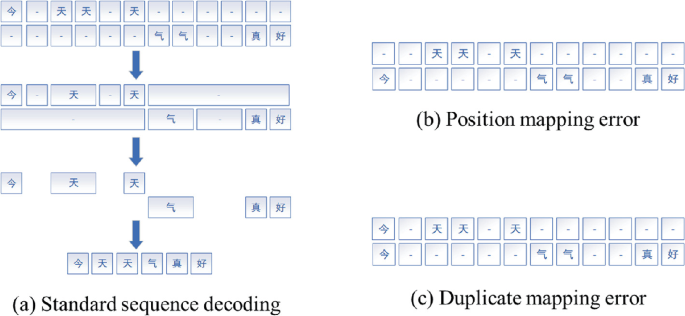
Two common mapping problems during decoding. a) A standard decoding process with duplicate removal and blank character removal; b) text is incorrectly mapped to an adjacent token; c) text is repeatedly predicted by multiple tokens.
3.3 Order-Align Strategy
One of the critical internal problems of full-page text recognition is the unknown number of characters to be recognized. So we must guarantee that the length of the sequence output from the encoder is greater than the maximum value of the sequence length in all data. CTC can handle such unaligned sequences relatively well. However, many blank tokens lead to degradation of the decoding effect. Especially when dealing with skewed text or images with large line spacing, problems such as those in Fig. 4 may occur. Words on the image may be mapped into adjacent tokens in the sequence or be duplicated. To solve these problems, we propose an order-align strategy to improve the orderliness of recognition results in the inference.
The execution flow of order-align strategy is described as follows. First, we iterate through each row of the 2D sequence and find the first non-zero element in each row, and once found use the current row and column as starting markers. Since there may be more than one empty line separating two rows, we traverse each element of the current row forward from the start marker, and if its upper and lower adjacent elements are not zero, we overwrite its value to the row where the start marker is located. Then, we mark the row where the non-zero element is located as the current row and continue traversing forward. Also, if we encounter the same character in the top and bottom adjacent elements, we keep only one character left.
The details are described in the \(Algorithm\,1\) below. In this way, we can move all elements on the upper and lower lines to the center line and then decode them to get an ordered string. This strategy can effectively improve the sequence orderliness in the inference stage. The effectiveness will be verified through experiments presented in Sect. 4.3 .
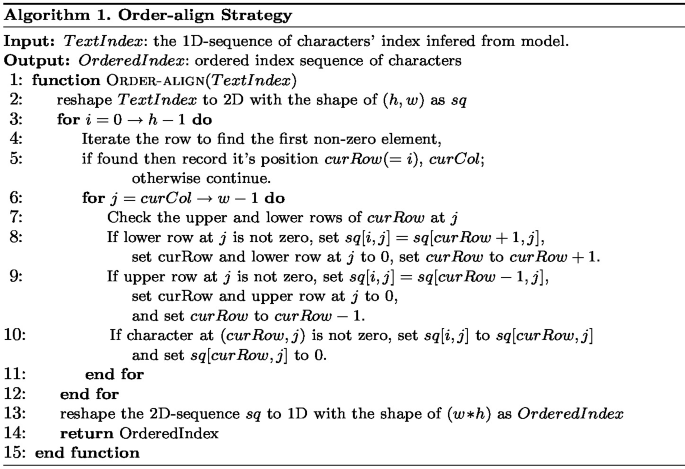
4 Experiments and Results
4.1 dataset.
The FPRNet is proposed to solve the handwritten Chinese essay recognition. We specially collected thousands of essay images by school-aged students from the four provinces of Heilongjiang, Jilin, Hebei, and Jiangsu. The collected images include different grid backgrounds, criticism marks, and captured using different methods. Some details of the experimental data is shown in the Table 2 .
Since the images were collected in different ways and vary greatly in color, lighting, and size. We needed a uniform pre-processing of the data. The maximum value filter and minimum value filter were executed first, and all images were unified by padding to 1440 pixels height and 720 pixels width. We collected a total of 2019 authentic images, using 1718 of them as the training set and the remaining 301 for testing. Statistically, the dataset contains a total of 3464 different characters, which covers almost all common Chinese characters.
In addition to the complete dataset described above, the state-of-the-art approach [ 16 ] we compare requires square multi-line text as input. Therefore, we select 938 images from Hebei and Jiangsu, slice them by paragraph, and padding them to 800 pixels height and 800 pixels width. We obtained a total of 2336 paragraph images, 2024 in the training set and 312 in the testing set.
Most of our experiments are carried out on the full-page dataset, and the experiments for comparison with baseline will be carried out on the paragraph dataset. The specific experimental results will be shown in Sect. 4.3 .
4.2 Experimental Setup
Our proposed FPRNet model works with the PyTorch framework and is trained on a single GeForce GTX TITAN X(12G) GPU. In all experiments, the networks are trained with the Adam [ 23 ] optimizer, with an initial learning rate of \(10^{-2}\) , exponentially decay to 0.001 over 180k steps. The weight decay factor is the same for all the convolution layers in FPRNet. We use the same default data augmentation module as in Origaminet for a fair comparison.
Three different metrics have been used in the experimental evaluation of the proposed method. One is the Character Error Rate (CER), using the Levenshtein Edit Distance algorithm. It is the ratio between insertion, deletion, and substitution errors and the total number of characters. The formula is as shown in Eq. 4
where \(k\) is the number of images in the data set. We also use the CER normalized by label length (nCER) to measure the recognition accuracy for a single image. In addition, We introduce BLEU, an indicator reflecting sentence fluency in machine translation. The higher the BLEU value, the better the fluency of the sentence. The calculation formula is Eq. 5 ,
where \(p_n\) represents the n-gram accuracy after text block correction, which reflects the accuracy of translation, and \(BP\) represents the penalty factor.
4.3 Experimental Results
In this section, we present the comparison with other approaches on the full-page Handwritten Chinese essay datasets and paragraph sub-datasets, which are introduced in the Sect. 4.1 . We compare our model with the OrigmaniNet [ 16 ] under different data inputs. The image in the paragraph datasets is an aspect ratio of 1, the same as the original paper. For encoders, we choose the recommended GTR-8 [ 24 ] to train. The other hyperparameters are the same as those set in the original paper. We also experimented with both baseline and FPRNet on the full-page dataset with an image aspect ratio of 2, which is a more suitable input specification for the HCER task. We also compare the recognition results with those of the mainstream handwritten OCR API service provided by Tencent. The results were shown in Table 3 .
From the results, we observe that our proposed FPRNet model achieves better performances with fewer parameters. Compared to the baseline model, our approach reaches a CER of 6.98% better than 10.25% on the paragraph datasets. On the full-page datasets, our approach also achieves a better performance with a CER of 7.58% comparing with the CER of 10.25% on baseline approach. As expected, the CER decreases from 7.58% to 5.83% along with the addition of order-align strategy, which directly demonstrates the effectiveness of the strategy.
In Table 3 , we also make a comparison between our proposed method and an influential handwritten OCR provided by Tencent, an industry-leading cloud service vendor, which employs the classic two-stage approach and trains on multiple levels of Chinese handwritten data. Evaluation on the full-page essay dataset yields a CER of 7.42%. Achieving comparable results without line annotations demonstrates the advantages of our proposed segmentation-free approach.
We further visualize the advantage of the proposed architecture and discuss the reasons for the experimental result. Figure 5 shows the saliency map of the same characters under our proposed method and OrigamiNet.By comparision,it can be found that the region of interest for each character in the baseline method is concentered around this line, while FPRNet achieves a better alignment to correspond the output text and its corresponding position.
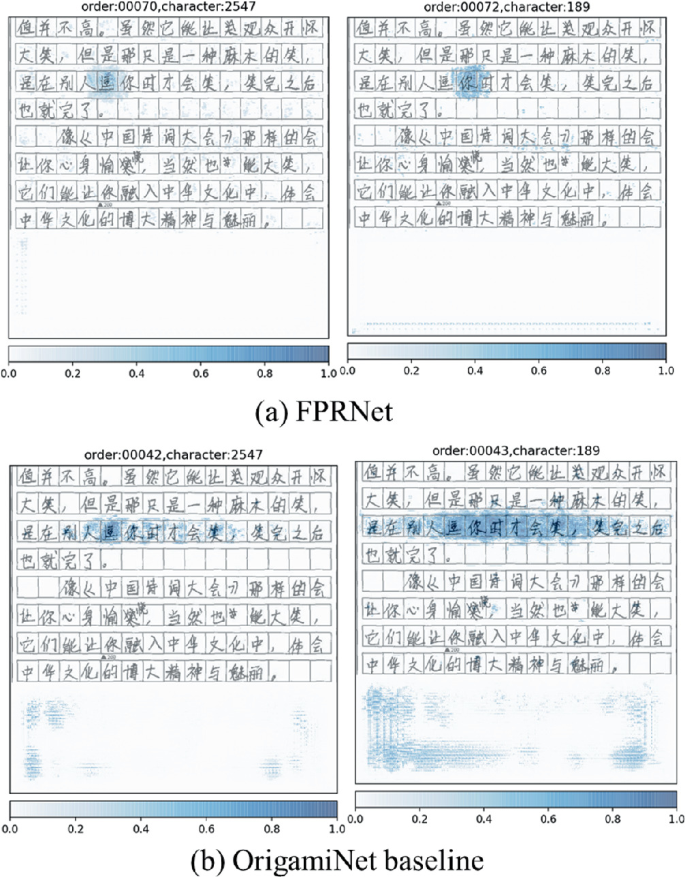
Saliency maps of FPRNet and OrigamiNet under the same sample.
5 Conclusion
In this paper, we propose an end-to-end full-page recognition network named FPRNet, performing well on the handwritten Chinese essay recognition (HCER) task. This method brings several advantages. First, the encoder incorporates new ideas from multi-resolution structure, which bring the ability to learn spatial pattern at different scales. Second, the reshape based dimensionality reduction mechanism applying to decoder achieves a better alignment to correspond the output text and its corresponding position. Finally, the proposed order-align strategy greatly guarantees the sequence orderliness of the inference stage.. On the HCER task, FPRNet achieves better results using fewer parameters than the baseline segmentation-free method. Comparable performance was also achieved compared to traditional two-stage methods.
Su, T., Zhang, T., Guan, D., Huang, H.: Off-line recognition of realistic Chinese handwriting using segmentation-free strategy. Pattern Recogn. 42 (1), 167–182 (2009)
Article MATH Google Scholar
Wang, Q., Yin, F., Liu, C.: Handwritten Chinese text recognition by integrating multiple contexts. IEEE TPAMI 34 (8), 1469–1481 (2011)
Article Google Scholar
Toledo, J., et al.: Handwriting recognition by attribute embedding and recurrent neural networks. In: ICDAR (2017)
Google Scholar
Lei, K., et al.: Convolve, attend and spell: an attention-based sequence-to-sequence model for handwritten word recognition. In: German Conference on Pattern Recognition (2018)
Wu, Y., Yin, F., Liu, C.: Improving handwritten Chinese text recognition using neural network language models and convolutional neural network shape models. Pattern Recogn. 65 , 251–264 (2017)
Graves, A., Fernández, S., Gomez, F., et al.: Connectionist temporal classification: labelling unsegmented sequence data with recurrent neural networks. In: Proceedings of the 23rd International Conference on Machine Learning, pp. 369–376 (2006)
Sandler, M., Howard, A., Zhu, M., et al.: Mobilenetv 2: inverted residuals and linear bottlenecks. In: CVPR (2018)
Chung, J., Delteil, T.: A computationally efficient pipeline approach to full page offline handwritten text recognition. In: ICDAR Workshop (2019)
Carbonell, M., Fornés, A., Villegas, M., et al.: A neural model for text localization, transcription and named entity recognition in full pages. Pattern Recogn. Lett. 136 , 219–227 (2020)
Messina, R., Louradour, J.: Segmentation-free handwritten Chinese text recognition with LSTM-RNN. In: ICDAR (2015)
Wu, Y., Yin, F., et al.: Handwritten Chinese text recognition using separable multi-dimensional recurrent neural network. In: ICDAR (2017)
Yousef, M., Hussain, K.F., Mohammed, U.S.: Accurate, data-efficient, unconstrained text recognition with convolutional neural networks. Pattern Recogn. 108 , 107482 (2020)
Bluche, T.: Joint line segmentation and transcription for end-to-end handwritten paragraph recognition. In: NeuIPS (2016)
Wigington, C., Tensmeyer, C., Davis, B., et al.: Start, follow, read: end-to-end full-page handwriting recognition. In: ECCV (2018)
Coquenet, D., Chatelain, C., Paquet, T.: End-to-end handwritten paragraph text recognition using a vertical attention network. IEEE Trans. Pattern Anal. Mach. Intell. (2022). (Accepted)
Yousef, M., Bishop, T.: OrigamiNet: weakly-supervised, segmentation-free, one-step, full page text recognition by learning to unfold. In: CVPR (2020)
Howard, A., Zhu, M., Chen, B., et al.: MobileNets: efficient convolutional neural networks for mobile vision applications. ArXiv:1704.04861 (2017)
Chollet, F.: Xception: deep learning with depthwise separable convolutions. In: CVPR (2017)
Wang, F., Jiang, M., Qian, C., et al.: Residual attention network for image classification. In: CVPR (2017)
Srivastava, R.K., Greff, K., Schmidhuber, J.: Highway networks. ArXiv:1505.00387 (2015)
Coquenet, D., Chatelain, C., Paquet, T.: Recurrence-free unconstrained handwritten text recognition using gated fully convolutional network. In: International Conference on Frontiers in Handwriting Recognition, pp. 19–24 (2020)
Szegedy, C., Liu, W., Jia, Y., et al.: Going deeper with convolutions. In: CVPR (2015)
Kingma, D., Ba, J.: Adam: a method for stochastic optimization. ArXiv:1412.6980 (2014)
Yousef, M., Hussain, K., Mohammed, U.: Accurate, data-efficient, unconstrained text recognition with convolutional neural networks. Pattern Recogn. 108 , 107482 (2020)
Coquenet, D., Chatelain, C., Paquet, T.: SPAN: a simple predict and align network for handwritten paragraph recognition. In: International Conference on Document Analysis and Recognition (2021)
Download references
Acknowledgment
Great thanks to Jifeng Wang. This work was supported by the National Key Research and Development Program of China (Grant No. 2020AAA0108003) and National Natural Science Foundation of China (Grant No. 62277011 and 61673140).
Author information
Authors and affiliations.
School of Software, Harbin Institute of Technology, Harbin, People’s Republic of China
Tonghua Su, Hongming You, Shuchen Liu & Zhongjie Wang
You can also search for this author in PubMed Google Scholar
Corresponding author
Correspondence to Tonghua Su .
Editor information
Editors and affiliations.
Walmart Inc., Hoboken, NJ, USA
Utkarsh Porwal
Universitat Autònoma de Barcelona, Barcelona, Spain
Alicia Fornés
National University of Sciences and Technology (NUST), Islamabad, Pakistan
Faisal Shafait
Rights and permissions
Reprints and permissions
Copyright information
© 2022 The Author(s), under exclusive license to Springer Nature Switzerland AG
About this paper
Cite this paper.
Su, T., You, H., Liu, S., Wang, Z. (2022). FPRNet: End-to-End Full-Page Recognition Model for Handwritten Chinese Essay. In: Porwal, U., Fornés, A., Shafait, F. (eds) Frontiers in Handwriting Recognition. ICFHR 2022. Lecture Notes in Computer Science, vol 13639. Springer, Cham. https://doi.org/10.1007/978-3-031-21648-0_16
Download citation
DOI : https://doi.org/10.1007/978-3-031-21648-0_16
Published : 25 November 2022
Publisher Name : Springer, Cham
Print ISBN : 978-3-031-21647-3
Online ISBN : 978-3-031-21648-0
eBook Packages : Computer Science Computer Science (R0)
Share this paper
Anyone you share the following link with will be able to read this content:
Sorry, a shareable link is not currently available for this article.
Provided by the Springer Nature SharedIt content-sharing initiative
- Publish with us
Policies and ethics
- Find a journal
- Track your research
- Share full article

Chinese Company Under Congressional Scrutiny Makes Key U.S. Drugs
Lawmakers raising national security concerns and seeking to disconnect a major Chinese firm from U.S. pharmaceutical interests have rattled the biotech industry. The firm is deeply involved in development and manufacturing of crucial therapies for cancer, cystic fibrosis, H.I.V. and other illnesses.
A WuXi Biologics facility in Wuxi, China. WuXi AppTec and an affiliated company, WuXi Biologics, have received millions of dollars in tax incentives to build sprawling research and manufacturing sites in Massachusetts and Delaware. Credit... Imaginechina Limited, via Alamy
Supported by

By Christina Jewett
- April 15, 2024
A Chinese company targeted by members of Congress over potential ties to the Chinese government makes blockbuster drugs for the American market that have been hailed as advances in the treatment of cancers, obesity and debilitating illnesses like cystic fibrosis.
WuXi AppTec is one of several companies that lawmakers have identified as potential threats to the security of individual Americans’ genetic information and U.S. intellectual property. A Senate committee approved a bill in March that aides say is intended to push U.S. companies away from doing business with them.
But lawmakers discussing the bill in the Senate and the House have said almost nothing in hearings about the vast scope of work that WuXi does for the U.S. biotech and pharmaceutical industries — and patients. A New York Times review of hundreds of pages of records worldwide shows that WuXi is heavily embedded in the U.S. medicine chest, making some or all of the main ingredients for multibillion-dollar therapies that are highly sought to treat cancers like some types of leukemia and lymphoma as well as obesity and H.I.V.
The Congressional spotlight on the company has rattled the pharmaceutical industry, which is already struggling with widespread drug shortages now at a 20-year high . Some biotech executives have pushed back, trying to impress on Congress that a sudden decoupling could take some drugs out of the pipeline for years.
WuXi AppTec and an affiliated company, WuXi Biologics grew rapidly, offering services to major U.S. drugmakers that were seeking to shed costs and had shifted most manufacturing overseas in the last several decades.
WuXi companies developed a reputation for low-cost and reliable work by thousands of chemists who could create new molecules and operate complex equipment to make them in bulk. By one estimate, WuXi has been involved in developing one-fourth of the drugs used in the United States. WuXi AppTec reported earning about $3.6 billion in revenue for its U.S. work.
“They have become a one-stop shop to a biotech,” said Kevin Lustig, founder of Scientist.com, a clearinghouse that matches drug companies seeking research help with contractors like WuXi.
WuXi AppTec and WuXi Biologics have also received millions of dollars in tax incentives to build sprawling research and manufacturing sites in Massachusetts and Delaware that local government officials have welcomed as job and revenue generators. One WuXi site in Philadelphia was working alongside a U.S. biotech firm to give patients a cutting-edge therapy that would turbocharge their immune cells to treat advanced skin cancers.
The tension has grown since February, when four lawmakers asked the Commerce, Defense and Treasury Departments to investigate WuXi AppTec and affiliated companies, calling WuXi a “giant that threatens U.S. intellectual property and national security.”
A House bill called the Biosecure Act linked the company to the People’s Liberation Army, the military arm of the Chinese Communist Party. The bill claims WuXi AppTec sponsored military-civil events and received military-civil fusion funding.
Richard Connell, the chief operating officer of WuXi AppTec in the United States and Europe, said the company participates in community events, which do not “imply any association with or endorsement of a government institution, political party or policy such as military-civil fusion.” He also said shareholders do not have control over the company or access to nonpublic information.

Last month, after a classified briefing with intelligence staff, the Senate homeland security committee advanced a bill by a vote of 11 to 1: It would bar companies from receiving government contracts for work with Wuxi, but would allow the companies to still obtain contracts for unrelated projects. Government contracts with drugmakers are generally limited, though they were worth billions of dollars in revenue to companies that responded to the Covid-19 pandemic.
Mr. Connell defended the company’s record, saying the proposed legislation “relies on misleading allegations and inaccurate assertions against our company.”
WuXi operates in a highly regulated environment by “multiple U.S. federal agencies — none of which has placed our company on any sanctions list or designated it as posing a national security risk,” Mr. Connell said. WuXi Biologics did not respond to requests for comment.
Smaller biotech companies, which tend to rely on government grants and have fewer reserves, are among the most alarmed. Dr. Jonathan Kil, the chief executive of Seattle-based Sound Pharmaceuticals, said WuXi has worked alongside the company for 16 years to develop a treatment for hearing loss and tinnitus, or ringing in the ear. Finding another contractor to make the drug could set the company back two years, he said.
“What I don’t want to see is that we get very anti-Chinese to the point where we’re not thinking correctly,” Dr. Kil said.
It is unclear whether a bill targeting WuXi will advance at all this year. The Senate version has been amended to protect existing contracts and limit supply disruptions. Still, the scrutiny has prompted some drug and biotechnology companies to begin making backup plans.
Peter Kolchinsky, managing partner of RA Capital Management, estimated that half of the 200 biotech companies in his firm’s investment portfolio work with WuXi.
“Everyone is likely considering moving away from Wuxi and China more broadly,” he said in an email. “Even though the current versions of the bill don’t create that imperative clearly, no one wants to be caught flat-footed in China if the pullback from China accelerates.”
The chill toward China extends beyond drugmakers. U.S. companies are receiving billions of dollars in funding under the CHIPS Act, a federal law aimed at bringing semiconductor manufacturing stateside.
For the last several years, U.S. intelligence agencies have been warning about Chinese biotech companies in general and WuXi in particular. The National Counterintelligence and Security Center, the arm of the intelligence community charged with warning companies about national security issues, raised alarms about WuXi’s acquisition of NextCODE, an American genomic data company.
Though WuXi later spun off that company, a U.S. official said the government remains skeptical of WuXi’s corporate structure, noting that some independent entities have overlapping management and that there were other signs of the Chinese government’s continuing control or influence over WuXi.
Aides from the Senate homeland security committee said their core concerns are about the misuse of Americans’ genomic data, an issue that’s been more closely tied to other companies named in the bill.
Aides said the effort to discourage companies from working with WuXi and others was influenced by the U.S. government’s experience with Huawei, a Chinese telecommunications giant. By the time Congress acted on concerns about Huawei’s access to Americans’ private information, taxpayers had to pay billions of dollars to tear Huawei’s telecommunication equipment out of the ground.
Yet WuXi has far deeper involvement in American health care than has been discussed in Congress. Supply chain analytics firms QYOBO and Pharm3r, and some public records, show that WuXi and its affiliates have made the active ingredients for critical drugs.
They include Imbruvica, a leukemia treatment sold by Janssen Biotech and AbbVie that brought in $5.9 billion in worldwide revenue in 2023. WuXi subsidiary factories in Shanghai and Changzhou were listed in government records as makers of the drug’s core ingredient, ibrutinib.
Dr. Mikkael A. Sekeres, chief of hematology at the University of Miami Health System, called that treatment for chronic lymphocytic leukemia “truly revolutionary” for replacing highly toxic drugs and extending patients’ lives.
Janssen Biotech and AbbVie, partners in selling the drug, declined to comment.
WuXi Biologics also manufactures Jemperli, a GSK treatment approved by the Food and Drug Administration last year for some endometrial cancers. In combination with standard therapies, the drug improves survival in patients with advanced disease, said Dr. Amanda Nickles Fader, president of the Society of Gynecologic Oncology.
“This is particularly important because while most cancers are plateauing or decreasing in incidence and mortality, endometrial cancer is one of the only cancers globally” increasing in both, Dr. Fader said.
GSK declined to comment.
The drug that possibly captures WuXi’s most significant impact is Trikafta, manufactured by an affiliate in Shanghai and Changzhou to treat cystic fibrosis, a deadly disease that clogs the lungs with debilitating, thick mucus. The treatment is credited with clearing the lungs and extending by decades the life expectancy of about 40,000 U.S. residents. It also had manufacturers in Italy, Portugal and Spain.
The treatment has been so effective that the Make-A-Wish Foundation stopped uniformly granting wishes to children with cystic fibrosis. Trikafta costs about $320,000 a year per patient and has been a boon for Boston-based Vertex Pharmaceuticals and its shareholders, with worldwide revenue rising to $8.9 billion last year from $5.7 billion in 2021, according to a securities filing .
Trikafta “completely transformed cystic fibrosis and did it very quickly,” said Dr. Meghan McGarry, a University of California San Francisco pulmonologist who treats children with the condition. “People came off oxygen and from being hospitalized all the time to not being hospitalized and being able to get a job, go to school and start a family.”
Vertex declined to comment.
Two industry sources said WuXi plays a role in making Eli Lilly’s popular obesity drugs. Eli Lilly did not respond to requests for comment. WuXi companies also make an infusion for treatment-resistant H.I.V., a drug for advanced ovarian cancer and a therapy for adults with a rare disorder called Pompe disease.
WuXi is known for helping biotech firms from the idea stage to mass production, Dr. Kolchinsky said. For example, a start-up could hypothesize that a molecule that sticks to a certain protein might cure a disease. The company would then hire WuXi chemists to create or find the molecule and test it in petri dishes and animals to see whether the idea works — and whether it’s safe enough for humans.
“Your U.S. company has the idea and raises the money and owns the rights to the drug,” Dr. Kolchinsky said. “But they may count on WuXi or similar contractors for almost every step of the process.”
WuXi operates large bioreactors and manufactures complex peptide, immunotherapy and antibody drugs at sprawling plants in China.
WuXi AppTec said it has about 1,900 U.S. employees. Officials in Delaware gave the company $19 million in tax funds in 2021 to build a research and drug manufacturing site that is expected to employ about 1,000 people when fully operational next year, public records and company reports show.
Mayor Kenneth L. Branner Jr. of Middletown, Del., called it “one of those once-in-a-lifetime opportunities to land a company like this,” according to a news report when the deal was approved.
In 2022, the lieutenant governor of Massachusetts expressed a similar sentiment when workers placed the final steel beam on a WuXi Biologics research and manufacturing plant in Worcester. Government officials had approved roughly $11.5 million in tax breaks to support the project. The company announced this year that it would double the site’s planned manufacturing capacity in response to customer demand.
And in Philadelphia, a WuXi Advanced Therapies site next to Iovance Biotherapeutics was approved by regulators to help process individualized cell therapies for skin cancer patients. Iovance has said it is capable of meeting demand for the therapies independently.
By revenue, WuXi Biologics is one of the top five drug development and manufacturing companies worldwide, according to Statista , a data analytics company. A WuXi AppTec annual report showed that two-thirds of its revenue came from U.S. work.
Stepping away from WuXi could cause a “substantial slowdown” in drug development for a majority of the 105 biotech companies surveyed by BioCentury , a trade publication. Just over half said it would be “extremely difficult” to replace China-based drug manufacturers.
BIO, a trade group for the biotechnology industry, is also surveying its members about the impact of disconnecting from WuXi companies. John F. Crowley, BIO’s president, said the effects would be most difficult for companies that rely on WuXi to manufacture complex drugs at commercial scale. Moving such an operation could take five to seven years.
“We have to be very thoughtful about this so that we first do no harm to patients,” Mr. Crowley said. “And that we don’t slow or unnecessarily interfere with the advancement of biomedical research.”
Julian E. Barnes contributed reporting, and Susan C. Beachy contributed research.
Christina Jewett covers the Food and Drug Administration, which means keeping a close eye on drugs, medical devices, food safety and tobacco policy. More about Christina Jewett
Advertisement
Ricciardo blasts Stroll after Chinese GP collision
- Medium Text

Get weekly news and analysis on the U.S. elections and how it matters to the world with the newsletter On the Campaign Trail. Sign up here.
Reporting by Alan Baldwin in London, editing by Clare Fallon
Our Standards: The Thomson Reuters Trust Principles. New Tab , opens new tab

Sports Chevron
The National League's top rotation will be tested starting Monday evening as the visiting Philadelphia Phillies open a four-game series with the Cincinnati Reds.


IMAGES
VIDEO
COMMENTS
The Thousand Character Essay (Qian Zi Wen) ... Edited by Cambridge Chinese Classics, www.camcc.org Chapter 1 天地玄黃,宇宙洪荒。tian1 di4 xuan2 huang2, yu3 zhou4 hong2 huang1 The sky was black and earth yellow; space and time vast, limitless. 日月盈昃,辰宿列張。ri4 yue4 ying2 ze4, chen2 xiu4 lie4 zhang1 Sun high or low ...
In the first of a two-part post, we'll look at a letter sent in 1987 from a group of elementary school students to the anarchist writer Ba Jin (most famous for his 1931 novel The Family) as they struggle to cope with China's changing social values. In Part II, I'll translate Ba Jin's reply. Essays.
2. Determine the center, choose the right material. To conform to the fact that a typical, novel, so it's easy to attract the attention of people. 3. Make a good outline, determine the general, write enough words. 4. Sentence writing smooth, there is no wrong character, no wrong grammar in article. Emotion, it is very important.
Here are tips to help you get better at writing essays in Chinese. Cover image from Pexels Learn New Chinese Words. The key to communicating in a new language is learning as many words as you can. Take it upon yourself to learn at least one Chinese word a day. Chinese words are to essay writing what bricks are to a building.
Final Thoughts. Writing Mandarin is a challenging task that will test your language skills and make you think hard about how to apply what you've learned so far. It might be slow going to begin with, but that's great as it means you're pushing your limits and building on your existing skills. If you want to be able to master Mandarin, you ...
Takeaway to Improve Chinese Essay Writing. Keep an excel spreadsheet of 口语 (Kǒuyǔ, spoken Chinese) -书面语 (Shūmiànyǔ, written Chinese) pairs and quotes of sentences that you like. You should also be marking up books and articles that you read looking for new ways of expressing ideas. Using Chinese-Chinese dictionaries is really ...
Chinese Essay Phrases Used in Abstracts. The abstract should explain the purpose, method, results, and conclusion of your research, also highlighting the new ideas that you proposed; and do remember to keep your language concise while writing. The purpose of the abstract is to conclude and summarize the main contents of your essay so that the ...
2" " " Foreignwordswrittenin "pinyin"(butnotpropernames!) are"usually"italicized inthemain"text. "" The qipao"becamepopular"inShanghaiduringthelate1920s ...
For GCE O level Chinese exam, essay writing is in section 2 of Paper 1. In this section, students are expected to choose to write 1 out of 3 questions, and the 3 questions will be in one of the following categories: 情景文 (Scenario essay writing) 说明文 (Expository) 议论文 (Argumentative) 材料作文 (Material essay writing)
比方说 比如 例如. Use 'chengyus' (idioms). These are very commonly used in Chinese writing and will give your essay a sense of fluency and flair. Be careful to make sure you fully understand the meaning of the idiom and the context in which it can be used before using it in your work. Here are some useful 'chengyus' that can be used ...
As a Chinese student, learning how to write an essay in this language is very important. Here are tips to help you get better at writing essays in Chinese. You can also enter a city, course or keyword to search, such as: Private Shanghai Location Online Beijing Shanghai
The Chinese Essay. Though collections of Chinese fiction, poetry, and drama abound, there have been no English-language anthologies of Chinese essays on the market. Now, veteran sinologist David Pollard has selected and translated the best and most representative examples of Chinese prose writing from the third century to the contemporary period.
Secondary School students taking Higher Chinese Language. Secondary School students taking Chinese Language and would like to stretch your Composition skills and knowledge. Mode of payment for Ms Chen's Model Composition Pack is via bank / Paynow transfer. 1) Bank transfer (FAST): UOB 456-345-3375 OR. 2) Paynow to Mobile: +65 91558311.
The Chinese Essay. : Columbia University Press, 2002 - Education - 372 pages. Though collections of Chinese fiction, poetry, and drama abound, there have been no English-language anthologies of Chinese essays on the market. Now, veteran sinologist David Pollard has selected and translated the best and most representative examples of Chinese ...
Download free-response questions from past exams along with scoring guidelines, sample responses from exam takers, and scoring distributions. If you are using assistive technology and need help accessing these PDFs in another format, contact Services for Students with Disabilities at 212-713-8333 or by email at [email protected]. The ...
Essays. Translations. Write Me. Short stories and essays by a contemporary Chinese writer, Yafei Hu.
When I studied Chinese years ago, I would sometimes type out 6-paragraph essays to myself about topics of interest or current events, or even about something that happened earlier in the day (say a disagreement with someone or something). It didn't matter if my grammar was off (that came with time, looking things up, and practice).
Third, full-score compositions are regarded by the Chinese teachers as model essays for other high school students who are preparing for Gao Kao. They are more influential on Chinese students' writing and more practical than those Ke Wen written in the last century, as learners tend to follow immediate examples owing to the effect of peer ...
More practice. Register to some Chinese forums and start some arguments. Worked extremely well for my American friends. Read more and find ppl to revise it. Maybe try posting your writing in r/WriteStreakCN . Copy a sample paragraphs in a textbook and substitute words to develop a sense of flow.
The Chinese Essay. Edited and translated by David E. Pollard. 1999 400 pages ISBN 962-7255-21-1. Order. Table of Contents. Illustrations: 9: Acknowledgements: 10: Preface: 11: Skeleton Chronology: 16: Introduction: 17: ... The Full Moon Festival at the West Lake 西湖七月半 ...
For a start, I have prepared three articles below with audio on self-introduction speech examples, changing the variation of replies in Chinese for beginners when you introduce yourself in Mandarin. The questions and answers will revolve around: -. ① Chinese Greetings and Pronouns. ② Your Name and Surname. ③ Your Age.
In this section, we present the comparison with other approaches on the full-page Handwritten Chinese essay datasets and paragraph sub-datasets, which are introduced in the Sect. 4.1. We compare our model with the OrigmaniNet under different data inputs. The image in the paragraph datasets is an aspect ratio of 1, the same as the original paper.
Automatic essay evaluation, an essential application of natural language processing (NLP) technology in education, has been increasingly employed in writing instruction and language proficiency assessment. Because automatic Chinese Essay Evaluation (ACEE) has made some breakthroughs due to the rapid development of upstream Chinese NLP technology, many evaluation tools have been applied in ...
By Tariq Panja and Michael S. Schmidt. April 20, 2024 Updated 8:13 a.m. ET. In the first days of 2021, seven months before the pandemic-delayed Tokyo Olympics, 23 of China's best swimmers tested ...
The Saturday Essay. How I Built an AI-Powered, Self-Running Propaganda Machine for $105 I paid a website developer to create a fully automated, AI-generated 'pink-slime' news site, programmed ...
April 22, 2024, 12:01 a.m. ET. When Pinduoduo, the Chinese discount shopping app, debuted nearly a decade ago, the tech giants Alibaba and JD.com dominated China's e-commerce business. Pinduoduo ...
The decision by a Massachusetts solar company to abandon plans to build a $1.4 billion U.S. factory highlights the risks amid a flood of Chinese clean energy exports. Share full article. 89. A ...
Chinese steel imports account for less than 1% of U.S. demand, officials told reporters. But Chinese subsidies and programs mean its steel prices are 40% lower than U.S. prices, and the Biden ...
Lawmakers raising national security concerns and seeking to disconnect a major Chinese firm from U.S. pharmaceutical interests have rattled the biotech industry. The firm is deeply involved in ...
Item 1 of 2 Formula One F1 - Chinese Grand Prix - Shanghai International Circuit, Shanghai, China - April 21, 2024 Aston Martin's Lance Stroll in the pits during the race Pool via REUTERS/Andres ...